

Industrial Ethernet Book
The only publication worldwide dedicated to Industrial Ethernet Networking and the IIoT. Visit iebmedia.com for latest updates.

New website offers deepest, richest archive of Industrial Ethernet and IIoT content on the web.




View and/or download latest issue of Industrial Ethernet Book and past issues.
Search our database for in-depth technical articles on industrial networking.
Learn what's trending from 5G and TSN, to Single Pair Ethernet and more.
Keep up-to-date with new product introductions and industry news.
GET CONNECTED…
Industrial Ethernet in AI World
Ninety-five percent of manufacturers are investing in AI to navigate uncertainty and accelerate smart manufacturing, according to a new report from Rockwell Automation.
Rockwell announced the results in its 10th annual “State of Smart Manufacturing Report.” The global study surveyed more than 1,500 manufacturers across 17 of the leading manufacturing countries.
As manufacturers continue to face uncertainty driven by economic shifts, the report highlights how companies are turning to smart manufacturing technologies to manage risks, improve performance, and support their workforce. It also examines adoption of emerging technology, including artificial intelligence (AI), machine learning (ML), and cloud-based systems.
Key global findings include:
81% of manufacturers say external and internal pressures are accelerating digital transformation, with cloud/SaaS, AI, cybersecurity, and quality management ranking as the top areas of smart manufacturing technology investments.
95% of manufacturers have invested in, or plan to invest in, AI/ML over the next five years.
Organizations investing in generative and causal AI increased 12% year-over-year, signaling a maturing approach to advanced technologies beyond experimentation.
Cybersecurity ranks as the second biggest external risk, with 49% of manufacturers planning to use AI for cybersecurity in 2025 – up from 40% in 2024.
48% of manufacturers plan to repurpose or hire additional workers due to smart manufacturing investments. Additionally, 41% are using AI and automation to help close the skills gap and address labor shortages.
Quality control remains the top AI use case for the second year in a row, with 50% planning to apply AI/ML to support product quality in 2025.
Beyond these data points, the report reflects broader movement towards more efficient and adaptive operations. Manufacturers are using smart technologies to strengthen supply chains, accelerate sustainability initiatives and make faster, more informed decisions. There has also been a 5% rise in the importance of analytical and AI skills for leaders, showing that talent development and technical innovation must go hand in hand. Still, many manufacturers face challenges when implementing AI. Nearly half of respondents say the ability to apply AI is now an extremely important skill – up from just 10% last year.
Al Presher
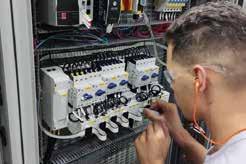

Industrial Ethernet Book
Editor: Al Presher, editor@iebmedia.com
Advertising: info@iebmedia.com
Tel.: +1 585-598-6627
Free Subscription: iebmedia.com/subscribe
Published by IEB Media Corp., 1247 Anthony Beach Rd., Penn Yan, NY, 14527 USA ISSN 1470-5745
Single Pair Ethernet: 28 New Products: 45
Unified locating key to Physical AI plus APL over Profinet testing
News releases emphasize the importance of unified locating as a key to physical AI, and new certified PROFINET over APL products now in field tests with end users.
Unified locating as a key to Physical AI
A collaboration between AIM-D, omlox / PI, and the OPC Foundation brings together the disciplines of identification, locating, and communication in a common spatial context.
Industrial automation is facing a paradigm shift: machines, robots, and mobile systems are learning to “understand” space. With the new OPC UA Companion Specification for Identification and Locating, AIM-D e.V., PROFIBUS & PROFINET International (PI) with the open locating standard omlox, and the OPC Foundation are establishing the foundation for a common language of “spatial intelligence.”
Physical AI, or AI that actively perceives physical space and acts contextually, requires a unified understanding of positions, movements, and identities in space. This is precisely where the new Companion Specification comes in: it harmonizes the spatial data model for absolute positions within the OPC Foundation and allows for a unified global positioning of assets in the physical and digital world.
This enables a seamless integration of spatial data into industrial IT and OT systems, a prerequisite for autonomous mobile robots, intelligent assistance systems, and selforganizing production environments.
The new specification is now freely available on the OPC Foundation’s website and is considered a milestone for the next evolutionary stage of industrial intelligence.
“Machines need a unified understanding of their position in space for coordinated interaction between stationary equipment and mobile robots in the flexible production of tomorrow,” explains Dr. Matthias Jöst, Committee Leader omlox at PI. “With the now available OPC UA Companion Spec, OPC Foundation, AIM-D, and PI jointly create the basis for a new generation of spatially networked and AI-enabled systems.”
“AIM particularly benefits from the connection between AutoID and locating technologies,” adds Peter Altes, Managing Director of AIM-D e.V. “The unified data model strengthens interoperability – a decisive prerequisite for digitally connected logistics and industry.”
Stefan Hoppe, President and Executive Director of the OPC Foundation, emphasizes: “OPC UA connects worlds – from identification
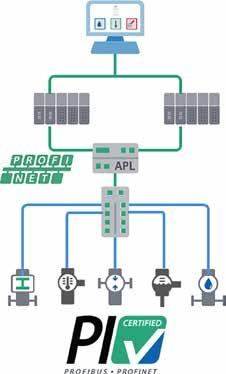
SOURCE: PI INTERNATIONAL
several pilot plants in the chemical industry. The basis for a high degree of interoperability is a certification test for all product types, including controllers, sensors, actuators, and switches. Tests for actuators have been added to the latest version of the PROFINET Test Bundle. The first products have already successfully passed the certification tests. For example, Samson has received the first certificates for its positioners.
"In addition to developing user-friendly technology and establishing targeted measures for product quality assurance, we believe that working with users is an important step in establishing the technology in plants and promoting its acceptance. For years, we have been working closely with users throughout the entire life cycle of technology. This begins with the creation of requirements and extends to the evaluation of prototypical or real products in pilot or demo systems. The experience gained in this process is incorporated into the maintenance and further development of our technologies," says PI Chairman Xaver Schmidt.
to locating to control. This new specification demonstrates how open standards together create true interoperability – making the industrial Internet of Things scalable and future-proof.”
The collaboration between AIM-D, omlox / PI, and the OPC Foundation brings together the disciplines of identification, locating, and communication in a common spatial context. This creates a decisive foundation to equip robots, vehicles, and machines with a shared spatial understanding – the key to Physical AI, resilient supply chains, and autonomous industrial ecosystems.
Certified PROFINET over APL products in field tests with users
The functionality of PROFINET for explosion-proof applications in process automation is available in its complete scope. In joint working groups, experts from PROFIBUS & PROFINET International (PI) are currently working closely with end-users to intensively evaluate the potential for use and interoperability of PROFINET over APL products from different manufacturers in
In addition to physical layer tests to verify suitability for intrinsically safe applications, the scope of certification testing for PROFINET over APL products includes additional APL-specific test cases for verifying PROFINET communication, the execution of an APL-specific test setup for interoperability scenarios, and tests for the Profile for PA Devices. With the availability of certification for actuators, the PI experts for PROFINET over APL have completed another step toward deployment in process automation.
In the meantime, end-users have positively evaluated the suitability of PROFINET over APL with certified products in several test lab installations. PI has initiated activities involving PI experts and users from the process industry to define further field tests. These will also be extended to the topic of security, considering the underlying non-Ethernet communication systems.
In addition, the topics of functional safety with PROFIsafe and the certification of switches are on PI's agenda, which are also being developed in close cooperation with end-users from the process industry.
Certification is now available for all device types with PROFINET over APL.
Machine learning for all automation sectors
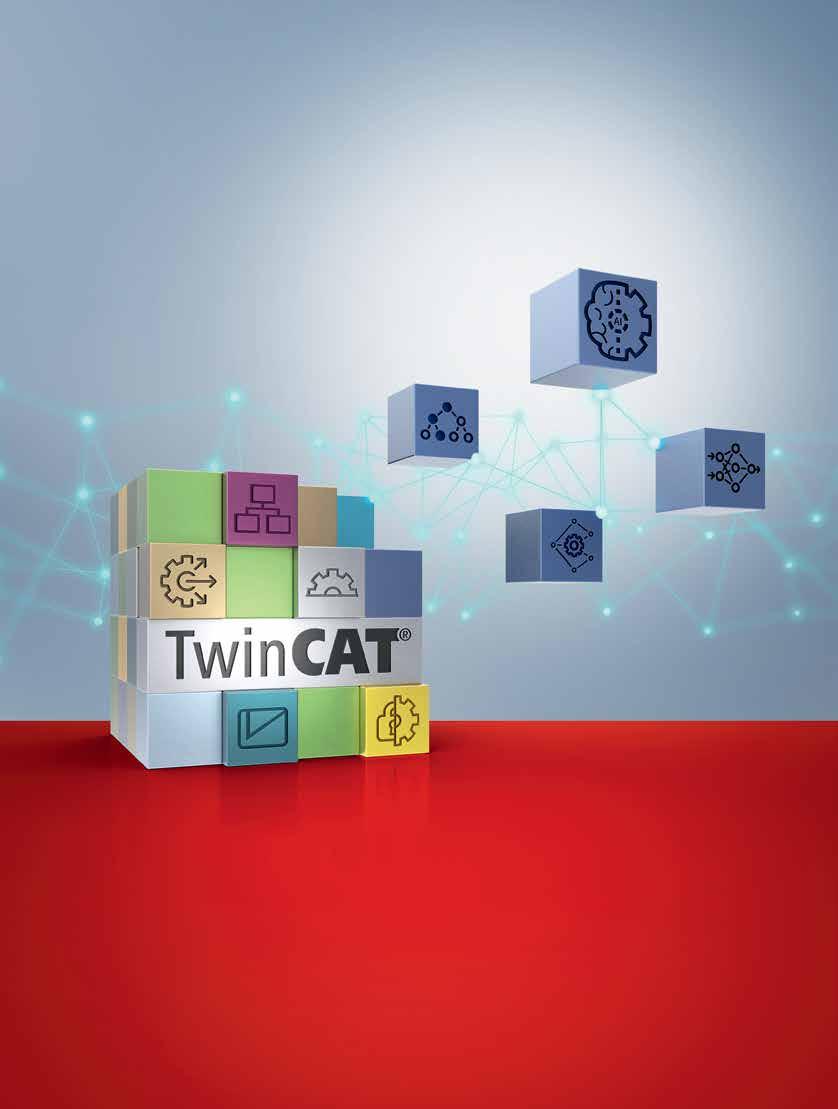
TwinCAT Machine Learning: AI is simply integrated into the control level
AI models as a function block in the PLC: AI as a component of the control code
real-time execution on the standard control IPC: in sync with motion, sequential logic, vision, and much more acceleration of complex AI models: Beckhoff IPC with NVIDIA GPU and interface from the PLC
automated training of AI models: AI model creation that doesn't require AI expertise
open interface for trained AI models (ONNX): trained AI with interoperability
AI model lifecycle management: model updates without compilation, stop, and restart
Industrial wireless technology solutions update
Industrial wireless technology trends include the continuing expansion of 5G, the integration of AI and machine learning into networks, the growth of Wi-Fi 6/6E/7 solutions and advancements in edge computing. AI is being used to automate network operations, enhance security and drive intelligence at the network edge.
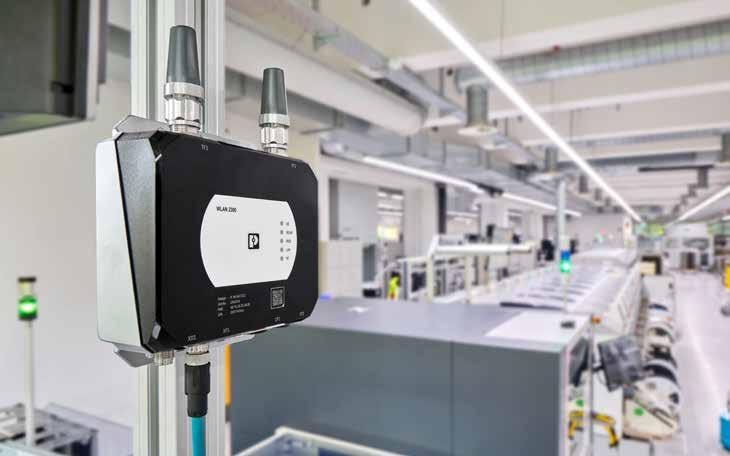
FOR OUR UPDATE ON INDUSTRIAL WIRELESS solutions, the Industrial Ethernet Book reached out to industry experts to get their perspective on the trends driving new technology. Not surprisingly, adoption of 5G is leading the way along with the emergence of Wi-Fi 6/6E and new developments with Wi-Fi 7. Add in AI, advancements in Time-Sensitive Networking (TSN) over wireless media and new 6GHz spectrum -- and the scope and evolution of the technology is apparent.
As Alice Masini of Cisco concluded, "the outlook for industrial wireless is marked by rapid growth, deeper integration, and expanding capabilities. As organizations increasingly value flexible, scalable, and reliable wireless connectivity, adoption of advanced solutions will continue to rise—extending well beyond traditional Wi-Fi or 5G alone."
Wi-Fi 6/6E and 5G solutions
NearFi technology offers very low latency, contactless energy and data transmission.
Phoenix Contact sees several key technologies enabling new Industrial Wireless solutions. Wi-Fi 6/6E brings higher capacity, deterministic communication and improved security with OFDMA, MU-MIMO and WPA3. The use of the 6 GHz band reduces interference and supports applications such as driverless transportation systems and moving machines.
“5G, especially in the form of campus networks, opens up a largely wireless factory infrastructure. It combines high reliability, low latency and real-time capability for industrial processes,” Jörg Brasas, Strategic Product Marketing, Business Unit Automation Infrastructure for PHOENIX CONTACT GmbH
told IEB. “NearFi technology also offers very low latency, contactless energy and data transmission via air gaps or non-conductive materials, ideal for wear-critical or moving components.”
Another trend is consistent security by design in accordance with IEC 62443: wireless solutions are embedded in holistic security concepts to ensure data integrity and network protection. With these technologies, Phoenix Contact creates scalable, robust and real-time capable wireless solutions "from the sensor to the network" and lays a foundation for flexible, secure and future-proof industrial applications.
Industrial 5G in smart factory operations
“Industrial 5G acts as a lever for more flexibility, real-time capability and efficiency
“5G, especially in the form of campus networks, opens up a largely wireless factory infrastructure. It combines high reliability, low latency and realtime capability for industrial processes,” Jörg Brasas, Strategic Product Marketing, Business Unit - Automation Infrastructure for PHOENIX CONTACT.
in the smart factory,” Brasas said. “From Phoenix Contact's point of view, 5G, together with Wi-Fi 6/6E, will make standardized real-time communication and high reliability widely available on an industrial scale for the first time. As a result, production systems can be networked largely wirelessly, which reduces wiring, speeds up conversions and seamlessly integrates mobile assets such as AGV/AMR.”
At the same time, the network capacity for sensor technology, condition monitoring and data-driven services increases. In practice, 5G enables deterministic communication in control processes, extends coverage over large plant areas and supports scalable fleets of autonomous systems.
Where rotating or moving applications have additional requirements, Phoenix Contact technologies such as NearFi (contactless energy and real-time Ethernet transmission) and Industrial WLAN/Wi-Fi 6 complement the 5G infrastructure - always thinking "from the sensor to the network". Security by design is also an integral component: Industrial Wireless solutions are embedded in IEC 62443-compliant concepts to ensure that the connectivity provided by 5G remains secure.
New industrial wireless technologies
New Industrial Wireless products from Phoenix Contact combine state-of-the-art wireless technologies with consistent cybersecurity. Wi-Fi 6/6E offers OFDMA, MU-MIMO and WPA3 for high data rates, low latency and reliable communication, while the 6 GHz band reduces interference. Series such as WLAN 1020/1120 combine client and soft access point functionality for mobile applications such as AGVs. In addition, NearFi enables contactless energy and real-time Ethernet transmission via air gaps - a unique selling point compared to previous solutions.
“In the 4G/5G sector, we are focusing on the simplest connection of devices and networks with END-to-END encryption with the new Celllulink devices,” Brasas said.
He added that “a key differentiating feature is the security-by-design strategy; all products meet the requirements of IEC 62443-4-1 (secure development process) and IEC 62443-4-2 (secure components). This includes features such as secure boot processes, cryptographic key management, role-based access control and encrypted communication.”
This ensures the integrity of the data and the resilience of the network - even in highly networked smart factory environments. This creates scalable, robust and future-proof wireless networks "from the sensor to the network".
Application areas
The latest industrial wireless solutions from Phoenix Contact are addressing central application areas of the smart factory. The
Two drivers are shaping the outlook for Industrial Wireless: Artificial Intelligence (AI) and virtual solutions. AI-supported analytics optimizes radio planning, roaming parameters and anomaly detection, while virtual radio evaluation/simulation and remote services accelerate commissioning and check changes in advance with low risk.
focus is on mobile transportation systems such as AGVs and AMRs, which require reliable wireless communication for navigation and fleet management. Wi-Fi 6/6E enables stable, low-latency networking in environments with a high density of devices - ideal for flexible material flows and intralogistics.
Another area is flexible machine integration: wireless solutions enable location-independent operation, set-up and maintenance of production systems via tablets or smartphones. For moving or rotating machine parts, Phoenix Contact offers NearFi, a contactless energy and real-time Ethernet transmission system that replaces wear-prone plug connections and reduces downtime costs.
It also addresses applications in the automotive industry, machine building and logistics, where robust communication under harsh conditions and high safety requirements are crucial. All solutions are developed according to IEC 62443 standards and offer security-by-design for the protection of critical data and processes. Phoenix Contact thus creates wireless networks that combine mobility, flexibility and security - from the sensor to the network.
Engineering challenges
Automation engineers face challenges such as high cabling costs, limited flexibility during conversions and the integration of mobile systems into existing networks. Phoenix Contact addresses these problems with advanced Industrial Wireless technologies.
“Wi-Fi 6/6E and 5G make wireless communication available for the first time with high reliability and low latency, so that mobile robots, AGVs and sensors can be integrated without complex cable infrastructure. This reduces installation costs and speeds up production adaptations,” Brasas said.
He added that another obstacle is communication in moving or rotating
applications, where cable wear leads to failures. With NearFi, Phoenix Contact offers contactless energy and real-time data transmission via air gaps - a solution that drastically reduces maintenance costs and downtimes.
“There is also growing pressure to ensure IT security in networked factories. Phoenix Contact integrates security-by-design in accordance with IEC 62443-4-1 and -4-2, minimizing risks such as tampering or data loss.” Brasas said. “The result: Advanced wireless solutions eliminate cabling constraints, increase flexibility and secure the smart factory against cyber threats.”
Looking to the future
From Phoenix Contact's perspective, Industrial Wireless will become a standard component of the Smart Factory in the coming years. Wi-Fi 6/6E and 5G will become widely available and carry real-time radio into control processes; additional 6 GHz channels and higher packet rates will allow larger, more densely occupied networks for mobile robotics, intralogistics and flexible machine islands.
NearFi expands the spectrum to include contactless energy and real-time Ethernet transmission for moving/wear-critical areas. At the same time, security-by-design in accordance with IEC 62443-4-1/-4-2 is becoming a basic requirement: future wireless products and solutions will have integrated, certifiable safety functions and thus accelerate the scaling of wireless networks.
Brasas said that two drivers in particular are shaping the outlook: AI and virtual solutions. AI-supported analytics optimizes radio planning, roaming parameters and anomaly detection (e.g. for condition-based maintenance), while virtual radio evaluation/ simulation and remote services accelerate commissioning and check changes in advance with low risk.

“Key technological trends driving new industrial wireless solutions include the introduction of Industrial 5G, advancements in Time-Sensitive Networking (TSN) over wireless media, and the adoption of the latest Wi-Fi standards with new 6GHz spectrum in several countries.” -- Daniel Mai, Director Industrial Wireless Connectivity Siemens AG.
Industrial 5G and Wireless TSN
Along with the adoption of the latest Wi-Fi standards with new 6GHz spectrum.
According to Daniel Mai, Director Industrial Wireless Connectivity at Siemens AG, “key technological trends driving new industrial wireless solutions include the introduction of Industrial 5G, advancements in Time-Sensitive Networking (TSN) over wireless media, and the adoption of the latest Wi-Fi standards with new 6GHz spectrum in several countries.”
Mai said that these technologies offer higher data rates, lower latency, and improved reliability, which are essential for modern industrial applications that need more and more connectivity. As a result, there is a growing acceptance and adoption of these wireless solutions across various industries, enabling more efficient and flexible operations.
“With growth of an ecosystem of end devices supporting these new technologies the adoption will be accelerated,” Mai said.
Industrial 5G impact
“Industrial 5G is significantly impacting smart factory operations by providing deterministic and highest reliability in wireless communications. This enables reliable real-time control of machines and processes, which was sometimes challenging with other wireless technologies. The enhanced
connectivity supports the deployment of autonomous vehicles and collaborative robots, improving the flexibility and efficiency of production lines,” Mai said.
Industrial 5G also facilitates seamless communication between a vast number of devices, contributing to more integrated and intelligent manufacturing environments. Additionally, the possibility to set up tailored private 5G networks utilizing private spectrum will enable secure and interference-free wireless connectivity on industrial campuses.
Unique capabilities
Mai added that the new products offer improved performance, higher data throughput, and support for deterministic wireless communication, enabling the wireless control of mission-critical applications. They meet the need for increasing connectivity, edge computing and higher data traffic in smart factories to collect and transfer data and thus enable data driven decisions and e.g. AI applications.
Compared to previous solutions, they also provide advanced cybersecurity measures and seamless integration with existing industrial protocols, enhancing both security and ease of deployment and creating a reliable OT-backbone.
The latest industrial wireless solutions are targeting business-critical applications that
require high bandwidth, deterministic, and reliable connectivity. This includes mobile robotics, remote monitoring and maintenance, augmented reality for training and complex assembly tasks, autonomous inspections, and process automation.
“The use of wireless for industrial control is becoming more prevalent, as modern wireless technologies have addressed many of the reliability and latency concerns that previously hindered their adoption. Industries are increasingly confident in deploying wireless solutions for a broader range of control applications,” Mai said. “A big game changer will be the introduction of AI to the industrial space. AI applications need data. Implementing a reliable wireless communication infrastructure will facilitate the easy deployment of additional sensors and edge devices in existing factories to feed AI and enable data driven decision making.”
Addressing challenges
Mai said that automation engineers often face challenges such as the inflexibility of wired networks and high installation costs, especially in existing installations. Advances in industrial wireless technology are helping to overcome these issues by providing increased mobility, flexibility, and real-time communication capabilities. This allows for easier reconfiguration of production
layouts and more scalable operations, also in brownfield environments.
“Looking to the future, the outlook for industrial wireless is promising, with expected continued innovations in areas like Industrial 5G, Wi-Fi technologies, and edge computing,” Mai concluded. “These advancements are likely to lead to fully connected and highly adaptable industrial environments, driving efficiency and productivity to new levels addressing the emerging economic challenges driven by global competition and upcoming retirement waves with the associated workforce shortage.”
Industrial Wireless Evolution
Driven by the rise of automation and rapid adoption of AI.
“The industrial wireless landscape is rapidly evolving, fueled by the rise of automation and the rapid adoption of AI. A new generation of wirelessly connected assets, including AI-driven robots, autonomous and automated vehicles, and data-rich endpoints such as cameras, demands networks that deliver ultra-low latency, high reliability, and seamless handoffs,” Alice Masini, Product Manager, Industrial Wireless at Cisco told the Industrial Ethernet Book recently.
Masini said that Wi-Fi 6E and Wi-Fi 7
have significantly increased bandwidth and device capacity, enabling high-performance connectivity in demanding industrial environments. While 5G continues to attract attention, it remains complex and costly for many organizations. Cisco Ultra-Reliable Wireless Backhaul (URWB), an extension of Wi-Fi, is specifically designed for critical applications that require more reliability than Wi-Fi alone can provide—applications that cannot tolerate communication loss and must remain connected even while roaming amid obstacles and RF interference.
Now, Wi-Fi and URWB are integrated within the same access points, greatly simplifying network operations, reducing costs, and giving industrial organizations the flexibility to choose the optimal wireless technology for each use case.
Impact of Industrial 5G
“Industrial 5G introduces valuable capabilities such as high capacity, low latency, and reliable connectivity for a wide range of smart factory applications. However, real-world experience shows that 5G is just one component in a broader connectivity strategy,” said Masini. Technologies like Wi-Fi and URWB also play vital roles in supporting robotics, automated guided vehicles (AGVs), real-time analytics, and remote operations. The greatest impact
comes when organizations evaluate their environments and use cases and deploy the optimal combination of technologies to meet their needs. While 5G can be complex and costly for some organizations, URWB provides private 5G-like performance without the need for licensed spectrum or the associated management overhead.
Wi-Fi and URWB can be operated simultaneously in a single access point, enabling manufacturers to manage both technologies through a single interface, reducing silos between IT and OT teams, and eliminating the need for duplicate infrastructure.
Ultimately, the transformative impact in smart factories lies in adopting a mix of wireless technologies that enable more adaptive, efficient, and secure operations—a holistic approach essential for modern industrial environments.
Technology innovation
Masini said that new industrial wireless solutions deliver greater flexibility, reliability, and operational simplicity. Cisco’s access points support both Wi-Fi and URWB on a unified hardware platform, allowing organizations to use high-bandwidth Wi-Fi for general connectivity and URWB for ultrareliable, low-latency applications—all with
Remote Machine Diagnostics and Commissioning








the same device.
“URWB’s “make-before-break” approach ensures uninterrupted connectivity for applications that cannot tolerate loss during roaming. Its Multipath Operations (MPO) technology duplicates critical traffic across multiple, uncorrelated frequencies to several access points, minimizing latency and maximizing reliability,” Masini said.
The capability to enable and configure URWB and Wi-Fi in the field help extend the lifespan of devices and protects investments. Additionally, the refreshed portfolio features compact, industrial-grade form factors for easy deployment in challenging environments. These innovations enable a seamless path to digitalization, supporting advanced automation and mobility while reducing complexity and total cost of ownership compared to previous generations of industrial wireless solutions.
New Industrial Wireless solutions
Masini added that the latest industrial wireless solutions are tailored for a broad spectrum of demanding applications, such as mobile automation, autonomous vehicles, robotics, real-time monitoring, and remote control across manufacturing, logistics, and warehouses. They address the connectivity requirements of AGVs, collaborative robots, and remote machinery, where constant, reliable communication is essential.
URWB provide seamless handoffs and uninterrupted service for fast-moving or mission-critical assets. Beyond mobile
applications, URWB’s near-zero latency increasingly supports data-driven use cases, including predictive maintenance, process optimization, and AI-powered analytics, all of which drive productivity and safety improvements.
“The flexibility of Wi-Fi and URWB integration enables precise adaptation to specific needs, from fixed sensors along production lines to mobile assets operating in expansive outdoor environments. As automation and digital transformation continue to accelerate, advanced wireless connectivity is pivotal for unlocking new efficiencies and operational insights,” Masini said.
Challenges
“Automation engineers must ensure reliable, always-on connectivity in dynamic and often harsh industrial settings, support seamless mobility for autonomous assets, and scale or reconfigure networks quickly as needs change. Advances in industrial wireless—especially the convergence of Wi-Fi and URWB—are addressing these challenges with robust, high-reliability connections and simplified management. Wi-Fi supports high-bandwidth needs while URWB supports high-reliability requirements,” Masini added.
Unified hardware platforms reduce network complexity and make it easier to upgrade or transition between wireless technologies as requirements evolve. Enhanced security features guard against growing cyber threats, while improved scalability allows for the rapid addition of new devices without major
infrastructure overhauls. These innovations empower automation engineers to deploy and operate advanced automation systems with increased confidence, agility, and efficiency for safer workplaces and more resilient industrial operations.
Industrial wireless outlook
“The outlook for industrial wireless is marked by rapid growth, deeper integration, and expanding capabilities. As organizations increasingly value flexible, scalable, and reliable wireless connectivity, adoption of advanced solutions will continue to rise— extending well beyond traditional Wi-Fi or 5G alone,” Masini said.
She added that integrating technologies such as Wi-Fi 6E, Wi-Fi 7, and URWB on unified platforms will further streamline operations, reduce costs, and support even the most demanding automation, AI-driven analytics, and autonomous system requirements. Ongoing innovations in reliability, security, and ease of deployment will position wireless connectivity as the foundation of industrial digital transformation.
“Looking forward, industrial wireless will enable new applications, drive higher operational efficiency, and support the shift toward more autonomous, data-driven, and adaptive industrial environments— empowering organizations to fully realize the benefits of Industry 4.0 and beyond,” Masini concluded.
Al Presher, Editor, Industrial Ethernet Book
"The industrial wireless landscape is rapidly evolving, fueled by the rise of automation and the rapid adoption of AI. A new generation of wirelessly connected assets, including AI-driven robots, autonomous and automated vehicles, and data-rich endpoints such as cameras, demands networks that deliver ultra-low latency, high reliability, and seamless handoffs,” -- Alice Masini, Product Manager, Industrial Wireless, Cisco.
Wi-Fi 7 trials demonstrate enterprise performance gains
Recent testing shows that Wi-Fi 7 delivers increased throughput, lower latency and enhanced efficiency for high-demand, real-world enterprise environments, setting a new standard for enterprise connectivity, according to recent research released by the Wireless Broadband Alliance (WBA).

WIRELESS BROADBAND ALLIANCE WI-FI 7 trials data released in 2025 demonstrate significant performance gains in real-world enterprise environments.
The Wireless Broadband Alliance, dedicated to driving the seamless and interoperable service experience of Wi-Fi across the global wireless ecosystem, announced the results of its Wi-Fi 7 industry trials in Enterprise Scenarios, conducted in collaboration with AT&T, CommScope (RUCKUS Networks), and Intel.
The trials, designed to evaluate Wi-Fi 7’s real-world performance, demonstrated significant improvements in throughput, efficiency and latency, highlighting Wi-Fi 7’s ability to support mission-critical enterprise applications such as XR, AI, cloud computing, and industrial IoT.
The WBA Wi-Fi 7 trials focused on assessing rate vs. range performance in enterprise settings, comparing Wi-Fi 7
with Wi-Fi 6E across the 5 GHz and 6 GHz bands. The tests which were conducted in live enterprise environments, revealed that Wi-Fi 7 delivers:
• Nearly double the throughput of Wi-Fi 6E at 5 GHz using 40 MHz channels
• Sustained 1 Gbps+ throughput up to 40 feet away from the access point (AP) in the 6 GHz band with 160 MHz channels
• Lower latency and improved efficiency, supporting next-gen applications such as AR/VR, video conferencing, and automation
• Greater network reliability, helping enterprises manage high-density environments with thousands of connected devices
• Downlink of 2 Gbps and reduced congestion with MLO
The trials assessed Wi-Fi 7’s capabilities in both controlled and real-world enterprise
environments, focusing on throughput, latency, and signal range across different frequencies and channel widths. A t 6 GHz with 160 MHz channels, Wi-Fi 7 achieved nearly 2 Gbps downlink throughput at close range, maintaining over 1 Gbps up to 40 feet away. In highdensity enterprise settings, where APs must support thousands of simultaneous connections, Wi-Fi 7’s enhanced spectral efficiency and Multi-Link Operation (MLO) provided more stable, reliable connectivity, mitigating network congestion even in heavily loaded conditions.
Addressing enterprise connectivity challenges for new and legacy devices
Findings demonstrate Wi-Fi 7’s ability to address key connectivity challenges in smart offices, manufacturing, healthcare, and immersive digital environments.
The WBA Wi-Fi 7 trials focused on assessing rate vs. range performance in enterprise settings, comparing Wi-Fi 7 with Wi-Fi 6E across the 5 GHz and 6 GHz bands. The tests which were conducted in live enterprise environments.
Commercial AFC Service, Enabling Standard Power Wi-Fi in 6 GHz Band Leveraging Critical Spectrum
Wireless Broadband Alliance Services (WBA Services), a subsidiary of the Wireless Broadband Alliance, has announced the commercial launch of WBA Services AFC, its Automated Frequency Coordination (AFC) service. The cloud-based platform is fully certified by the U.S. Federal Communications Commission (FCC) and enables the deployment of standard power Wi-Fi devices in the 6 GHz band (5.925–7.125 GHz) while ensuring they do not cause interference to existing incumbents, such as fixed microwave and radio astronomy links.
The launch of WBA Services AFC reflects the organization’s goal to advance global Wi-Fi innovation, delivering faster, more reliable, and more secure wireless connectivity. By enabling standard power devices in the 6 GHz band, WBA Services is unlocking a critical new spectrum resource for high-performance use cases such as enterprise networking, smart city infrastructure, industrial IoT, and immersive experiences like AR/VR. AFC enables more efficient use of the spectrum, benefiting not only infrastructure providers and service providers, but the millions of end users and businesses that rely on seamless, wireless broadband and low-latency access in homes, offices, stadiums, and public spaces.
The WBA Services AFC is based on the OpenAFC open-source specification and provides infrastructure manufacturers, service providers, and enterprises with dynamic frequency and power management based on device location and local spectrum conditions. This ensures compliance with regulatory requirements while maximizing spectrum availability and performance.
Tiago Rodrigues, CEO of Wireless Broadband Alliance Services, said: “As the demand for high-speed, low-latency wireless connectivity grows, the 6 GHz band represents a critical resource. Our AFC service empowers the ecosystem to harness this band responsibly and effectively. This is another great example of how WBA members’ work on AFC and across our working groups is leading the industry, driving new innovations and business opportunities for Wi-Fi technologies including Wi-Fi 6E and Wi-Fi 7 in a wide range of industrial, commercial and consumer use cases.”
AFC at the core of the 6 GHz opportunity
The AFC framework is vital for enabling standard power and outdoor Wi-Fi operations in the 6 GHz band. Devices query the WBA Services AFC to determine which frequencies and power levels are permitted at their location. This enables real-time, interferencefree spectrum use for high-performance deployments in enterprise campuses, public venues, and dense urban environments, without the need for additional spectrum licenses.
Enterprises that rely on real-time collaboration, video conferencing, AI-driven automation, and AR/VR applications will benefit from Wi-Fi 7’s lower latency and higher throughput, ensuring seamless user experiences without performance bottlenecks. The trials also confirmed that Wi-Fi 7 delivers significant improvements in 5 GHz networks, where many legacy devices still operate, ensuring backward compatibility and an easier transition for enterprises upgrading their infrastructure.
While This trial focused on 160 MHz channels in the 6 GHz band which would be typical for high-density commercial Wi-Fi 7 network deployments requiring many access points. However, most of today’s Wi-Fi 7 devices also support 320 MHz channels which would be more common for smaller networks, and enable even higher levels of performance for hybrid work and consumer experiences as documented in the recent WBA Wi-Fi 7 Trial report for residential settings.
Here is what industry experts had to say about the future of Wi-Fi 7.
Tiago Rodrigues, President and CEO of the Wireless Broadband Alliance
"Wi-Fi 7 is not just an evolution, it’s a game changer for enterprise connectivity. These trials prove that Wi-Fi 7 offers real-world improvements in speed, reliability, and
efficiency that businesses need to support the next generation of applications. As adoption accelerates, enterprises will see tangible benefits in everything from hybrid work and immersive experiences to AI-driven automation. The WBA is committed to ensuring the industry has the data and insights needed to maximize Wi-Fi 7’s potential."
JR Wilson, VP, Tower Strategy & Roaming at AT&T
"Enterprises are demanding more from their Wi-Fi networks than ever before. These trials confirm that Wi-Fi 7 can deliver the high-performance, low-latency connectivity required for modern digital environments. At AT&T, we see Wi-Fi 7 as a key enabler for businesses looking to optimize their operations and embrace the future of connectivity."
Mittal Parekh, Senior Director, Business Development RUCKUS Networks at CommScope
"Wi-Fi 7 introduces groundbreaking features like Multi-Link Operation (MLO) and 4K QAM, which significantly enhance network efficiency and throughput. Our participation in these trials has demonstrated how enterprises can leverage these advancements to enable the most demanding applications in the most challenging environment in a variety of industry verticals.”
Eric A. McLaughlin, VP & GM Connectivity Solutions Group, Intel Corporation
"6 GHz Wi-Fi 7 marks a major leap forward in wireless technology, and the results of our collaboration in these trials reinforce its real-world benefits. Business PC users can enjoy enhanced productivity and collaboration experiences in the office or in hybrid work scenarios as 160 MHz channel use scales broadly across corporate networks and 320 MHz channels become mainstream at home. With improved spectrum utilization and dramatic performance improvements, the findings of the trial help underscore Wi-Fi 7’s ability to meet the needs of next-gen applications in enterprise, industrial, and residential settings."
Driving Wi-Fi 7 adoption
Following these successful trials, the WBA will continue to collaborate with industry leaders to accelerate Wi-Fi 7 adoption, refine implementation strategies, and support enterprises in leveraging Wi-Fi 7’s full potential.
To learn more about the WBA’s Wi-Fi 7 initiatives and trial findings, visit The Road to Wi-Fi 7 link below.
Technology article by the Wireless Broadband Alliance (WBA).
Learn More
Meeting the demands of evolving industrial wireless connectivity
By leveraging Wi-Fi and URWB, industrial enterprises can unlock the full potential of agile, resilient and intelligent wireless networks—empowering them to lead the way in deploying next-generation, AI-powered solutions across even the most challenging environments.
INDUSTRIAL ORGANIZATIONS ARE AT A pivotal moment. As digital transformation accelerates, the demand for robust, agile, and secure wireless networks is skyrocketing. The rise of automation, artificial intelligence (AI), and mobility is fundamentally changing how industrial environments operate.
Today’s wireless networks are now expected to support not just more devices and applications, but also to underpin mission-critical operations where reliability is non-negotiable.
The growing complexity of industrial wireless
Modern industrial wireless networks face a unique and complex set of technical challenges:
Device density: The sheer volume of connected sensors, cameras, and mobile assets can lead to congestion and interference.
Diversity of devices and applications: Networks must support everything from legacy sensors to bandwidth-hungry 4K cameras and real-time AI applications— each with distinct performance needs.
Demand for high speeds: Applications like high-definition video, AR/VR, and AI-powered vision systems require higher data rates than traditional wireless can always provide.
Ultra-Low latency needs: Real-time control and analytics depend on minimal lag for safety, efficiency, and fast decisionmaking.
Security and reliability: As more businesscritical processes move to wireless, the network must be both highly reliable and highly secure, ensuring uninterrupted operations.
Operationally, network managers are also navigating increased complexity:
Agility and scalability: Wireless networks are expanding rapidly, often beyond traditional office spaces, even as IT budgets and resources remain constrained.
Consistent performance: Delivering seamless coverage and a consistent user experience, even in high-density or interference-prone areas, remains a constant challenge.
Security and compliance: Protecting the
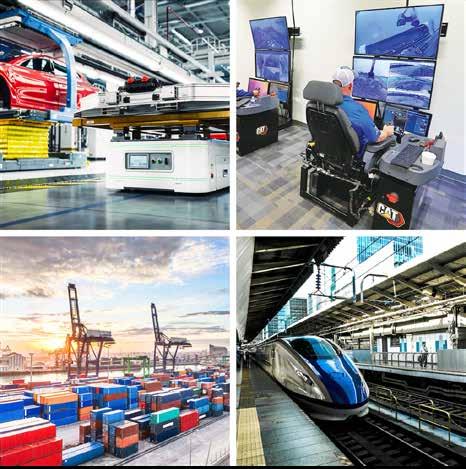
network from unauthorized access and cyber threats, while ensuring regulatory and corporate compliance, is more crucial than ever.
The good news is that wireless technologies are evolving rapidly to meet these demands. Let’s look at three key advances shaping the future of industrial connectivity:
Wi-Fi 7: Raising the Bar for Wireless Performance
Wi-Fi 7 is the latest evolution in wireless networking, offering significant improvements in speed, capacity, and efficiency. With support for higher throughput, lower latency, and advanced management of dense device environments, Wi-Fi 7 is well suited for many industrial
applications—from high-definition video streaming and AR/VR to large-scale IoT deployments. Its improved spectrum utilization and multi-link operation help organizations overcome many traditional bottlenecks, setting a new benchmark for enterprise wireless.
Private 5G: powerful, but not without hurdles
Private 5G networks are generating excitement for their potential to deliver ultra-low latency, strong security, and robust support for a diverse range of industrial use cases. However, deploying Private 5G can be complex. It often requires dedicated spectrum licenses, specialized expertise, and a significant upfront investment in infrastructure. For
URWB has been used across different industrial settings to support mission-critical applications that require near-zero latency and uninterrupted hand-offs.
many organizations, these factors make widespread adoption a longer-term goal rather than an immediate solution.
URWB: purpose-built for industrial reliability
Ultra-reliable Wireless Backhaul (URWB) addresses the specific needs of missioncritical applications that are very sensitive to latency or require uninterrupted roaming.
URWB delivers the ultra-low latency, seamless mobility and consistent reliability that traditional wireless technologies may struggle to guarantee in harsh, dynamic, or mobile industrial environments.
URWB is built on 802.11, and like Wi-Fi, it operates in unlicensed spectrum which simplifies deployment and reduces costs. URWB delivers near-zero latency (<10ms) and seamless handoffs —enabled by key technical innovations:
• An end-to-end overlay technology emulates a virtual switch over 802.11 wireless links to deliver ultra-low latency (<10ms).
• Ultra-fast failover in less than 500ms delivering carrier-grade availability.
• “Make-before-break” handoffs ensures moving assets establish a reliable connection with a new access point before dropping connectivity from the previous access point.
• Multipath Operations (MPO) technology replicates high-priority packets via up to 8 different paths on uncorrelated frequencies at the same time to multiple access points, exploiting time, spatial, and frequency diversity.
This functionality, combined with cutting edge hardware capability, can further reduce latency and improve reliability, addressing both interference and hardware failures.
With these capabilities, URWB is able to bridge the gap between the promise of next-generation wireless and the realities of industrial operations— enabling organizations to confidently connect autonomous vehicles, robotics, remote sensors, and more, even in the most demanding settings. URWB has been successfully used across diverse industrial settings:
In factories, warehouses and healthcare facilities, it keeps hundreds of automated guided vehicles continuously connected, boosting uptime and workplace safety.
In mines, it enables critical remote control of unmanned vehicles in treacherous terrain, ensuring instant response for improved precision and safety.
In ports, it connects cranes, machinery, and automated vehicles, feeding real-time data to Terminal Operating Systems to maximize port capacity, throughput, and efficiency.
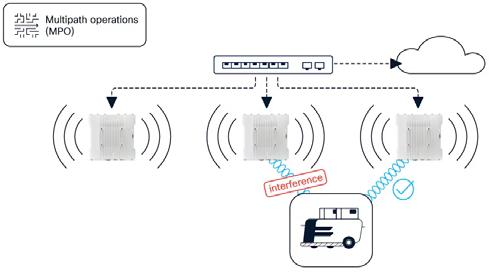
Multipath Operations (MPO) technology replicates high-priority packets via up to 8 different paths on uncorrelated frequencies at the same time to multiple access points.
And on the rails, it ensures continuous telecommunications for traffic management, delivering safer, more efficient, and highercapacity rail operations.
URWB has been used across different industrial settings to support missioncritical applications that require near-zero latency and uninterrupted hand-offs.
Tackling operational complexity with unified wireless integration
Together, Wi-Fi and URWB offer an unparalleled wireless solution, with Wi-Fi supporting high-speed, low-latency requirements and URWB ensuring reliable communication for applications that require ultra-low latency and seamless roaming.
That is why we integrated URWB and Wi-Fi technologies in a wide selection of our Wi-Fi 7, 6E and 6 access points enabling organizations to unlock new use cases and capabilities without overhauling their existing network.
URWB and Wi-Fi technologies are now integrated in a wide selection of Cisco Wi-Fi access points enabling organizations to support a wider range of devices and applications while streamlining deployments, simplifying management, and reducing costs.
This unified approach offers several advantages:
Streamline deployment and save costs: Both Wi-Fi and URWB operate simultaneously on the same hardware platform, so there is no need to duplicate the infrastructure.
Simplified operations: Administrators can manage URWB and Wi-Fi from a single pane of glass using Wireless LAN Controllers (WLC) or Cisco Catalyst Center. This greatly simplifies network operations and lifecycle management.
Increased security: Security policies can
be pushed across Wi-Fi and URWB networks.
End-to-end solution: Wi-Fi with URWB access points come in a variety of form factors supporting indoor, outdoor and industrial use cases eliminating complexities, and the additional cycles of dealing with point solutions and multiple vendors.
By bringing together the strengths of high-speed Wi-Fi and ultra-reliable URWB, Cisco delivers a comprehensive wireless solution that supports a wide range of industrial use cases—without the need for costly network overhauls or complex, siloed systems.
The future of industrial wireless
As industrial organizations accelerate their digital transformation, driven by the adoption of AI and automation, the need for reliable, high-performance wireless connectivity will only grow.
Cisco’s integrated approach—combining the robust capabilities of URWB with the operational flexibility and performance of our Wi-Fi access points—empowers organizations to power complex, innovative use cases, such as autonomous systems, predictive analytics, and real-time monitoring, all of which require seamless, always-on connectivity.
By leveraging Wi-Fi and URWB, industrial enterprises can unlock the full potential of agile, resilient, and intelligent wireless networks—empowering them to lead the way in deploying next-generation, AI-powered solutions across even the most challenging environments.
Patricia Costa, Sr. Marketing Manager, Industrial Wireless, Cisco.
Learn More
IEB Special Report: Industrial Ethernet in an AI World
As AI makes an impact, smart manufacturing is looking for solutions that combine automation, AI and secure architectures from edge-to-cloud to optimize operations and reduce exposure to cyber, compliance and operational risks. The immediate goals: cybersecurity, quality control, logistics and process optimization.
The Impact of AI in Smart Manufacturing
Smart manufacturing is expected to be profoundly changed with the infusion of a wide array of AI technologies, and anticipated advances in cybersecurity, machine learning, use of Big Data and cloud computing architectures. The future of Industrial Ethernet networks will be fundamentally shaped by advances in artificial intelligence (AI) and virtual technologies.
THE IMPACT OF AI ON INDUSTRIAL ETHERNET is expected to result in profound changes to the fundamental landscape of industrial networks according to industry experts that the IEB interviewed for this special report. Here are a few of the findings:
AI technology is poised to profoundly influence automation and control networking by requiring networks to become faster, more reliable, and more secure while also driving the adoption of smarter, more flexible architectures. Industrial Ethernet networks will be fundamentally shaped by advances in artificial intelligence (AI) and virtual technologies. AI will be used to create more adaptive, secure, and self-optimizing Industrial Ethernet networks.
Read on to learn details on how Industrial Ethernet will evolve and adapt in an AI world.
Speed, reliability and security
Industrial networks using AI must be scalable, flexible, and high bandwidth.
“AI technology is poised to profoundly influence automation and control networking by requiring networks to become faster, more reliable, and more secure while also driving the adoption of smarter, more flexible architectures,” Vivek Bhargava, Product Marketing Manager at Cisco told the Industrial Ethernet Book recently.
Bhargava said that, because AI is limited by the quality of its input data, industrial networks must gear up to deliver pristine, comprehensive data to AI applications. This data needs to be gathered from as many sources as possible to include all causalities, must be transmitted without hiccups so as
not to lose any important packets, must be secured and protected, and delivered in near real-time to avoid delays.
“AI's demands directly translate into specific network requirements. To gather the maximum data from all available sources, the network must be scalable, flexible, and high bandwidth. To maintain an uninterrupted data stream, it needs to be resilient, recovering from failures quickly without dropping packets. Furthermore, the network must offer robust security to protect sensitive data and guarantee low-latency, low-jitter data transmission for time-sensitive AI applications,” Bhargava said.
Technology megatrends
“Newer industrial switches offer key hardware features to meet modern network demands.
in the data center
Nervous system is the network





Physical components in the field

Network





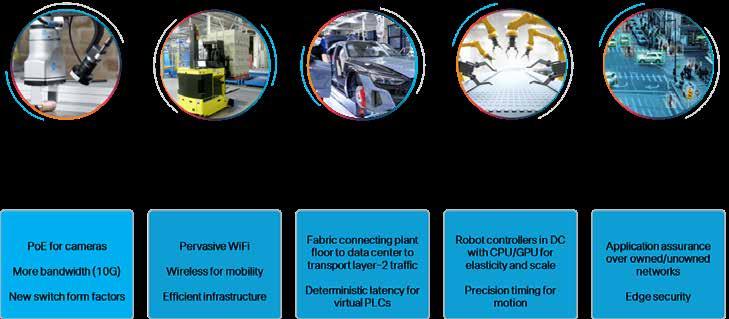
They provide multiple high-speed 10 Gbps uplinks. high-density, high-wattage Power over Ethernet (PoE) to simplify deployment, and flexible connectivity options with both copper and fiber ports,” Bhargava said.
“Designed for harsh environments, they feature compact form factors and IP67 ratings for use in confined or moisture-prone areas.”
Similarly, Industrial wireless is evolving to support industrial AI by delivering highly reliable, near-zero latency, seamless handoffs even at high speeds, and uninterrupted secure connectivity tailored for industrial applications.
He added that, from a software perspective, a number of features are critical for industrial
AI. Software-defined networking enables scaling the network and making it flexible to adapt to changes quickly. Built-in visibility for connected devices and traffic, segmentation based on access policies and zero-trust principles, and secure remote access is critical for keeping out malware, protecting data, and easy access to configuring and monitoring devices.
Finally, comprehensive visibility across both owned and unowned networks is vital for proactively identifying and resolving potential issues.
From a connectivity perspective, it is important that the industrial networks seamlessly and securely connect to the
enterprise network to reach to datacenters and cloud, enabling data-driven decision making, remote monitoring and control, and for regulatory compliance.
Key application areas
“Industrial Ethernet enables a broad and diverse set of AI and automation use cases. Some of the key ones that are gaining rapid popularity include machine vision systems, adaptive robotics, software-defined automation, and sustainability,” Bhargava said.
Machine vision systems, used for product quality assessment, barcode scanning, and robotic coordination, require industrial
The industrial network connects assets to intelligence.
Industrial AI’s reliance on high-performance networking.

"AI
switches for high-wattage PoE and high-speed ports to connect cameras to continuously learning and inferencing AI applications in co-located servers.
AI-driven adaptive robotics for tasks such as tactile insertion and valve manipulation use a variety of sensors that need highbandwidth, low-latency, and resilient connectivity to function effectively.
Software-defined automation technology used to virtualize industrial PCs (IPC) and programmable logic controllers (PLCs) also depend on low-latency low-jitter networks with a scalable fabric to tunnel Layer-2 control messages between machines and their controllers.
“By collecting vast data through their networks, manufacturers use AI to simulate scenarios that directly improve industrial efficiency, product quality, and reduce energy consumption, thereby increasing sustainability,” Bhargava added.
Looking into the future Bhargava said that the challenges facing automation engineers in the future are largely driven by the demands of Industry 4.0 and the increasing complexity of OT networks due to the necessity of connecting an unprecedented number of sensors, actuators,
and devices.
“Modern Industrial Ethernet switches are empowering automation engineers to upgrade operations and accelerate innovation. These switches with their high-speed ports, highwattage PoE, low-latency switching, built-in security, and resiliency, enable a shift toward flexible software-based solutions and ensure engineers have the timely data needed for superior decision-making,” Bhargava said.
Modern switches also significantly benefit OT teams and automation engineers by enabling faster troubleshooting to minimize unplanned downtime, maintaining operational agility, and optimizing PoE power usage. Moreover, modern switches facilitate a necessary partnership between IT and OT. By standardizing the OT network to be compatible with IT infrastructure, organizations can leverage the same management tools, apply consistent security policies enterprise-wide, and utilize existing IT expertise within the operational domain.
Paradigm shift for industrial networks
Industrial Ethernet networks will be fundamentally shaped by advances in artificial intelligence (AI) and virtual technologies.
“The future of Industrial Ethernet networks will be fundamentally shaped by advances in artificial intelligence (AI) and virtual technologies. Phoenix Contact views AI as a key driver in optimizing network management, fault diagnosis and predictive maintenance,” said Julia Reker, Director Network Technology, Industry Management and Automation for PHOENIX CONTACT GmbH. “AI-based systems analyze network data in real time, detect anomalies at an early stage, and enable automated responses-a crucial step towards self-healing networks.”
Reker said that virtual solutions such as digital twins, complement this development by creating virtual replicas of physical networks. These enable simulation-based planning, commissioning and optimization of communication structures-particularly in complex automation environments.
Combined with Industrial Ethernet and wireless technologies such as Wi-Fi 6 or 5G, highly available, adaptive networks are emerging that meet the growing demands for flexibility, security and data availability.
Phoenix Contact positions itself as a solution provider that integrates and further develops both traditional Ethernet infrastructures and AI-based, softwaredefined network concepts.
technology is poised to profoundly influence automation and control networking by requiring networks to become faster, more reliable, and more secure while also driving the adoption of smarter, more flexible architectures. Because AI is limited by the quality of its input data, industrial networks must gear up to deliver pristine, comprehensive data to AI applications," -- Vivek Bhargava, Product Marketing Manager, Cisco Industrial IoT.

Key technology trends
According to Reker, industrial communication is on the brink of a paradigm shift. Phoenix Contact sees the combination of highperformance hardware, AI-driven software and flexible connectivity solutions as the key to the future of industrial Ethernet networks. Technologies such as Time-Sensitive Networking (TSN) enable the deterministic convergence of IT and OT worlds, while wireless real-time communication via 5G and Wi-Fi 6 creates new levels of freedom in automation.
“Virtual solutions such as digital twins and AI-based network diagnostics are transforming planning, commissioning and maintenance-shifting from reactive to predictive processes. REST APIs in communication modules open new avenues for automated machine integration. At the same time, cybersecurity is moving into focus, with IEC 62443-compliant solutions ensuring networks are resilient and futureproof,” said Reker.
Phoenix Contact is pursuing a holistic approach where Industrial Ethernet is becoming not only faster and more flexible, but also smarter serving as the backbone for tomorrow’s intelligent, connected production.
Industrial Ethernet solutions
“Industrial Ethernet is a key enabler for digital transformation in machine and
process automation,” Reker said. “Phoenix Contact sees its role not only in technological advancement, but also as an active architect of the All Electric Society-a vision of the future where energy from renewable sources is used efficiently, intelligently and entirely electrically.”
In this context, she added that Industrial Ethernet enables seamless networking of machines, sensors and controllers, both wired and wireless via 5G and Wi-Fi 6. This is essential for mobile applications such as AGVs or modular production lines.
Virtual solutions such as digital twins and AI-based diagnostic systems support predictive maintenance and optimize energy flows in real time. In this way, Industrial Ethernet becomes the infrastructure for a connected, energy-efficient and CO2-neutral production environment-in line with the All Electric Society.
Automation engineering challenges
Reker said that automation engineers are facing increasing complexity: rising volumes of data, shorter innovation cycles and more stringent cybersecurity requirements. Phoenix Contact addresses these challenges with a future-oriented Industrial Ethernet portfolio that combines openness, scalability and intelligence. A central focus is the convergence of both IT
and OT technologies.
“Technologies such as Time-Sensitive Networking (TSN) enable deterministic communication over a shared network-the foundation for virtualized control systems and software-defined architectures. This is complemented by wireless real-time communication via 5G and Wi-Fi 6, which supports mobile applications such as AGVs or modular machine concepts,” Reker said.
“Virtual solutions such as digital twins and AI-supported diagnostic systems help to manage complexity and automate maintenance processes. At the same time, Single Pair Ethernet (SPE) creates new opportunities for seamless communication right down to the field level," she added.
Adaptive, secure, selfoptimizing networks
AI can assist with intelligent network configuration for optimal performance and redundancy.
According to Pooyan Dehghani, Product Marketing Manager at Moxa Europe GmbH, “AI will be used to create more adaptive, secure, and self-optimizing Industrial Ethernet networks. It can assist with intelligent network configuration for optimal performance and redundancy. Beyond
“The future of Industrial Ethernet networks will be fundamentally shaped by advances in artificial intelligence (AI) and virtual technologies. Phoenix Contact views AI as a key driver in optimizing network management, fault diagnosis and predictive maintenance,” -- Julia Reker, Director Network Technology, Industry Management and Automation for PHOENIX CONTACT GmbH.
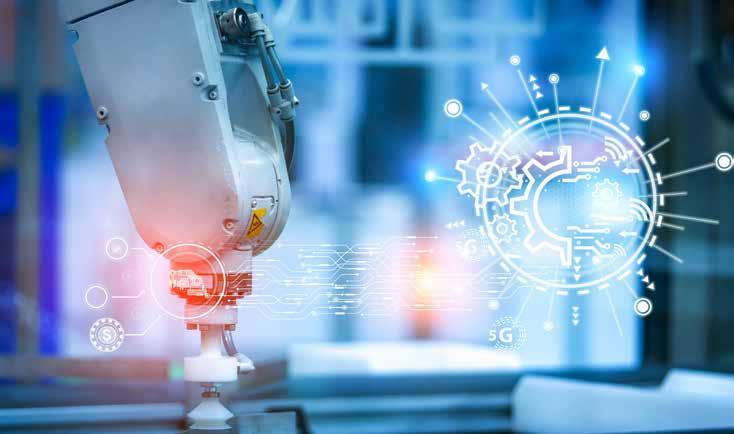
“AI will be used to create more adaptive, secure, and self-optimizing Industrial Ethernet networks. It can assist with intelligent network configuration for optimal performance and redundancy. Beyond setup, AI can monitor performance and automatically reroute traffic, adjust priorities, or reconfigure topology based on production needs or failures,” -- Pooyan Dehghani, Product Marketing Manager at Moxa Europe GmbH.
setup, AI can monitor performance and automatically reroute traffic, adjust priorities, or reconfigure topology based on production needs or failures.”
Dehghani added that machine learning trained on network traffic can recognize unusual activity and detect attacks.
“AI and ML support predictive maintenance by identifying potential issues before they become visible. In time-sensitive environments, integrating AI with TSN enables dynamic bandwidth allocation, lower latency, and adaptive responses to real-time traffic,” Dehghani said. “Pairing AI with digital twins allows 'what-if' modeling to predict bottlenecks and test configurations before deployment.”
The future of Industrial Ethernet
Dehghani said that high-performance switches and routers are required to support TSN and deterministic Ethernet, plus robust edge devices that can help move processing closer to the factory floor.
A key development is AI-powered switches that embed AI or ML into network hardware. These switches enable autonomous optimization, predictive diagnostics, and enhanced cybersecurity by analyzing traffic in real time to improve reliability and reduce latency.
“AI-powered platforms are being
integrated into network design, monitoring, and optimization. Advanced management solutions use AI and ML to detect abnormalities, optimize traffic, and simplify troubleshooting and device configuration,” Dehghani said. “The same analytics can strengthen cybersecurity by detecting unusual behaviors and threats.”
Key application areas
Dehghani added that both process and discrete manufacturing are under pressure to become more data-driven, adaptable, and efficient, while meeting rising cybersecurity and performance demands. In discrete industries such as electronics, packaging, and automotive, Industrial Ethernet connects machines, robots, and enterprise systems in real time.
This enables instant data sharing for quality control, production tracking, and order visibility, which supports more adaptable and resilient operations. In process industries such as energy, food and beverage, and pharmaceuticals, Ethernet-based networks help ensure continuous and safe operation while improving sustainability.
Real-time optimization across remote plants, predictive maintenance, and tighter process control are all supported. Combined with edge computing and AI, Industrial Ethernet provides a fast, predictable,
and secure backbone for fully connected, intelligent manufacturing. Standardized Ethernet communication lets data flow from the shop floor to enterprise and supply chain systems for better visibility and decisionmaking.
“Automation engineers still face complex troubleshooting, manual device setup, and rising cybersecurity threats. Configuring each device from discovery to deployment is timeconsuming and error-prone,” Dehghani said. “Finding the root cause of network issues can be difficult and costly, and keeping every device updated and secure is a constant task.”
He added that new Industrial Ethernet solutions with AI capabilities are starting to help. Intelligent tools can monitor performance, automate configuration, and assist with troubleshooting.
“AI and ML can sift large volumes of network data to detect early warning signs, forecast failures, and suggest maintenance before disruptions occur,” Dehghani said. “They can also enhance defenses by detecting anomalous activity. AI is not a magic fix, so human oversight remains essential. In industrial networks, where reliability is critical, engineers interpret, validate, and refine AI’s suggestions.”
Al Presher, Editor, Industrial Ethernet Book
Advancing Physical AI safety systems in manufacturing
New virtual safety fence and real-time quality inspection systems use industrial-grade network infrastructure. Accenture, NVIDIA, and Belden are creating safer, smarter, and more connected industrial operations where the physical and digital worlds converge.

BELDEN. HAS COLLABORATED WITH ACCENTURE to help develop and deploy physical AI systems for worker safety in factories and warehouses. The systems demonstrate how time-sensitive network infrastructure enables advanced AI applications that enhance worker safety, improve quality control and modernize existing factory operations as modern manufacturing increasingly integrates autonomous systems alongside human operators.
"By providing the full stack of technology from sensor to edge, we're enabling manufacturers to implement advanced AI safety systems using existing factory infrastructure."
Belden’s virtual safety fence solution was developed with Accenture’s “Physical AI Orchestrator,” which uses NVIDIA Omniverse, NVIDIA Metropolis libraries for digital twins and agentic AI from Accenture. It applies computer vision and closed-loop control to
monitor worker movements and automatically pause robotic operations when humans enter hazardous zones.
Following the pilot project completed in September, the virtual safety fence solution is now expected to be commercially deployed at an automotive manufacturer for pedestrian safety in warehouse environments later this year. "The physical AI safety systems we are building represent our evolution from

Accenture's Physical AI Orchestrator, powered by NVIDIA Omniverse and NVIDIA Metropolis libraries and integrated with Belden's Time-Sensitive Network, enables real-time monitoring and orchestration.
Accenture, NVIDIA, and Belden are creating safer, smarter, and more connected industrial operations where the physical and digital worlds converge.
Making Safer Spaces: NVIDIA and Partners Bring Physical AI to Industrial Infrastructure
Advanced blueprints, vision language models and synthetic data generation extensions accelerated by NVIDIA RTX PRO 6000 Blackwell GPUs enhance productivity and improve safety across environments.
Physical AI is becoming the foundation of smart cities, facilities and industrial processes across the globe. NVIDIA is working with companies including Accenture, Avathon, Belden, DeepHow, Milestone Systems and Telit Cinterion to enhance operations across the globe with physical AI-based perception and reasoning.
The continuous loop of simulating, training and deploying physical AI offers sophisticated industrial automation capabilities, making cities and infrastructure safer, smarter and more efficient. For example, physical AI applications can automate potentially dangerous tasks for workers, such as working with heavy machinery. Physical AI can also improve transportation services and public safety, detect defective products in factories and more.
Advancing Physical AI

Accenture is collaborating with Belden, a leading provider of complete connection solutions, to enhance worker safety by creating smart virtual fences that factories can place around large robots to prevent accidents with human operators.
The smart virtual fence is a physical AI safety system that uses an OpenUSD-based digital twin and physics-grounded simulation to model complex industrial environments. Using computer vision-based mapping and 3D spatial intelligence, the system is adaptive to increased variability in the dynamic human-robot interactions that occur in a modern shopfloor environment.
Accenture taps into the NVIDIA Omniverse platform and Metropolis to build and simulate these smart fences. With Omniverse, Accenture created a digital twin of a robot arm and workers moving in a space. And with Metropolis, the company trained its AI models and deployed them at the edge with video ingestion and the NVIDIA DeepStream software development kit (SDK)’s real-time inference capabilities.
connectivity products to comprehensive industrial solutions," said German Fernandez, VP of Ecosystem Partner Programs at Belden. "By providing the full stack of technology from sensor to edge, we're enabling manufacturers to implement advanced AI safety systems using existing factory infrastructure."
Enabling synchronized precision for safety-critical applications
The technical breakthrough centers on Belden's Time Sensitive Networking (TSN) capabilities, which enable microsecondprecise synchronization of video streams from multiple cameras across factory floors. This synchronization is essential for accurate tracking of people and equipment movement in real-time safety applications.
"The physical AI systems we help Belden build on Accenture’s Physical AI Orchestrator platform address the critical need to protect workers while maintaining the operational flexibility that modern manufacturing demands," said Ramalingam Hariharan, a managing director at
Accenture.
"Industrial-grade networking protocols are critical for safety applications that require precise timing," said Fernandez. "Our TSN technology enables real-time, closed-loop control between AI systems and production equipment, which is fundamental for both safety and quality applications."
Belden’s physical AI systems also demonstrate real-time quality inspection capabilities. During another pilot project with pharmaceutical blister packs, AI-powered vision systems successfully identified incomplete or damaged packages and automatically triggered robotic removal systems while maintaining full production speed.
Belden’s new physical AI systems are the result of each company's core capabilities: Belden provides industrial networking infrastructure and protocol integration with embedded security; NVIDIA provides simulation, agentic AI and accelerated computing platforms; and Accenture brings expertise and capabilities in physical AI, manufacturing automation, systems integration, industry and reference architectures.
Supporting manufacturing transformation
Belden’s new physical AI systems address two key manufacturing challenges: labor shortages and enabling rapid facility modernization. As manufacturers struggle to find experienced workers, AI-enhanced safety systems help protect newer personnel by providing intelligent hazard detection and automated safety responses.
The integrated approach reduces both infrastructure costs and complexity while improving overall equipment effectiveness. The same network infrastructure that handles safety monitoring can simultaneously manage quality inspection and other industrial applications, demonstrating the multi-service network capabilities that distinguish the breadth of Belden's automation solutions.
Belden and Accenture
Learn More
Photo courtesy of Belden and Accenture.
AI-based tech cuts operational costs by 35 percent
Building X deployed as central operational system at the San Juan de Dios Hospital in Seville, Spain, has enhanced efficiency and sustainability. The digital building platform, with its AI-based apps, integrates energy management, security, and HVAC systems into a single solution.
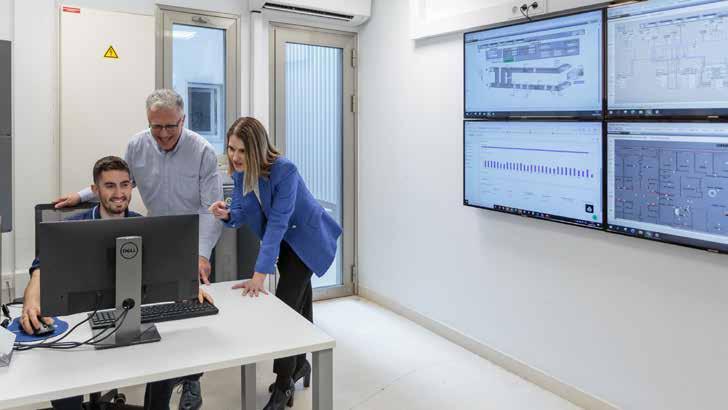
SIEMENS SMART INFRASTRUCTURE HAS partnered with San Juan de Dios Hospital in Seville, Spain, to transform it into a smart and sustainable asset. With buildings accounting for around 40 percent of global carbon emissions, and healthcare facilities increasingly facing financial and sustainability pressures, improving operational efficiency is crucial.
Digital building technology
At San Juan de Dios Hospital, Siemens has turned this challenge into an opportunity with its AI-based digital building technology. By deploying its innovative solutions Siemens enabled the hospital to cut operating costs of the analyzed assets by 35 percent, setting another benchmark for hospitals across the globe.
San Juan de Dios Hospital, which enjoys a history spanning more than 450 years, has undergone impressive transformation using Siemens’ fully digital, AI-powered building platform Building X and digital services. The solution integrates energy and security
management, as well as Heating, Ventilation and Air Conditioning (HVAC) automation into a single system. This leads to significant operational as well as energy efficiency gains for building managers. Siemens’ technology and services are expected to enable a further reduction of 10 percent in operating costs, thanks to early fault detection and optimized equipment use.
BuildingX technology
“With Siemens’ technology, we have gone beyond simple automation. We now have an intelligent system that coordinates, optimizes, and anticipates the functioning of our facilities, improving care quality and the well-being of those around us,” said María Jesús Pareja, Managing Director at San Juan de Dios Hospital.
“This project sets another benchmark for hospital digitalization globally. By harnessing AI and interoperable platforms, healthcare facilities can transform operational complexity into simplicity and resilience – ultimately improving care outcomes while cutting costs,”
said Delphine Clément, Global Head of Verticals at Siemens Smart Infrastructure Buildings.
At San Juan de Dios Hospital in Seville, Siemens has deployed a digital layer that integrates remote digital services for fault detection and diagnostics, intrusion detection via Siemens’ Siveillance Suite, and the Desigo CC building management system. As part of the Building X platform, Operations Manager and Energy Manager provide real-time visibility into building performance and energy consumption, enabling smarter decision-making, improved operational efficiency, and measurable sustainability gains.
Building X is a digital building platform that supports customers to digitalize, manage, and optimize their building operations. It is part of Siemens Xcelerator, an open digital business platform that enables customers to accelerate their digital transformation easier, faster and at scale.
Siemens
Digital building platform, Building X, with its AI-based apps integrates energy management, security, and HVAC systems into a single solution.
AI and machine learning in autonomous trains and trolleys
Artificial Intelligence and Machine Learning technology applies reasoning with uncertainty, autonomous path planning, collision avoidance, swarm technology and sensor fusion support to autonomous trains and trolleys.
A TECHNICAL OVERVIEW ON THE USE OF Artificial Intelligence (AI)/Machine Learning (ML) illustrates how it can be applied in autonomous passenger and freight trains.
It describes how, on train wagons, AI/ ML applications can be connected to a single Gigabit Ethernet network that uses the Common Industrial Protocol (CIP). The network connects all sensors, controllers, and actuators in the wagons, as well as wired and wireless entertainment, and feeds the information to the AI/ML applications.
Artificial Intelligence/Machine Learning (AI/ML) subjects (reasoning with uncertainty, autonomous path planning, collision avoidance, swarm technology, sensor fusion, etc.) are used to support the use cases of trains and trolleys.
Grade of Automation
The IEC 62290-1:2014 standard defines various levels of automation and the minimum mandatory functions required to achieve these levels referred to as Grades of Automation (GoA). This standard focuses on rail automation for public transit systems such as subways, metros or commuter trains referred to as Urban Guided Transport (UGT). The standard defines five levels of automation:
• GoA 0 – Line of Sight Operations
• GoA 1 – Non-Automated Train Operation
• GoA 2 – Semi Automated Train Operation
• GoA 3 – Driverless Train Operation
• GoA 4 – Unattended Train Operation
The IEC 62290-1:2014 standard defines a set of minimum mandatory functions a system must implement. These mandatory functions are:
• Ensure the safe movement of trains: Ensure a safe train route; Ensure a safe separation of trains; Ensure a safe speed.
• Drive the train: Control acceleration and braking.
• Supervise guideway (i.e. train tracks): Prevent collision with obstacles; Prevent collision with persons on track.
• Supervise passenger transfer: Control passenger doors; Prevent injuries to persons between cars; Prevent injuries to persons between platform and trains; Ensure safe starting conditions.
• Operate a train: Put in or take out of operation; Supervise status of the train.
• Ensure detection and management of emergency situations: Detect fire/smoke;

and machine learnng offer a powerful duo.
Detect derailment; Detect loss of train integrity; Manage passenger requests (call/evacuation, supervision)
The mandatory functions are either the operation staff responsibility or performed by an automated/autonomous system.
GoA 0 – Line of Sight Operations
In the GoA 0 level all train movements and control of wayside elements (such as track switches) are managed by manual operational procedures executed by an Operation Staff. There are no mandatory functions executed by an automated/autonomous system.
For example, if a train is required to move from a storage lane to a transfer track, it is the responsibility of the train operator to ensure the switches are in the correct position and ensure the train does not collide with the train ahead.
For example, if a train is required to move from a storage lane to a transfer track, it is the responsibility of the train operator to ensure the switches are in the correct position and ensure the train does not collide with the train ahead.
GoA 1 – Non-Automated Train Operation
A GoA 1 level system is considered a conventionally signaled system common to all subway or metro systems. The IEC 62290-1
SOURCE: ISOTCKPHOTO
specification has allocated the “Ensure Safe Movement of Trains” mandatory functions to the Automated/Autonomous System.
The Automated/Autonomous System uses Automatic Train Protection (ATP) will: determine if it is safe for a train to proceed by locking switches and setting the aspect of the signals, checks that speed is compatible with permitted limits and activate an emergency brake if necessary.
The Operator/Driver is responsible for: opening and closing train doors and determining if it is safe to depart a platform, control braking, propulsion and reading the wayside signals accurately before moving the train forward, responding to emergencies or sudden changes.
GoA 2 – Semi Automated Train Operation
The GoA 2 level is where an automation/ autonomous system becomes more effective. This is one of the most-common levels of automation today. The jump from GoA1 to GoA2 is an order of magnitude higher than the jump to any other grade (for example from GoA2 to 3 or GoA3 to 4) due to the complexity and amount of automation required.
The Automated/Autonomous system is responsible for the following processes: accelerating and stopping the train, supervising speed, and braking when exceeding speed limits, determining the train’s position on the track, transmitting data from the vehicle to a wayside monitoring system and requesting authorization for the route.
The Operator/Driver is still present to perform several vital tasks as well as take over if the system should fail: Stopping the train if there are obstructions or if a person has fallen on the track; Be mindful of crews working alongside tracks and appropriately adjust speed; Open and close train doors; Authorize departure from the station.
GoA 3 – Driverless Train Operation
In GoA 3 level, the automated/autonomous system controls the train between platforms. There’s no driver, but there are attendants on the train. In this level, starting and stopping are automated and a train attendant operates the doors and drives the train in case of emergencies.
A train equipped with a GoA 3 automated/
AI
Mandatory Functions
Operation Staff Automated/Autonomous System
Ensure Safe movement of trains Yes no
Drive Train Yes no
Supervise guideway Yes no
Supervise passenger transfer Yes no
Operate a train Yes no
Ensure detection & management of emergency situations Yes no
GoA 1 – Non-Automated Train Operation (NTO)
Mandatory Functions Operation Staff Automated/Autonomous System
Ensure Safe movement of trains no Yes
Drive Train no Yes
Supervise guideway Yes no
Supervise passenger transfer Yes no
Operate a train
Yes no
Ensure detection & management of emergency situations Yes no
Table 2: GoA 1 – Non-Automated Train Operation (NTO).
autonomous system is aware of its surroundings along the track. Trackside devices installed along the track detect obstacles that may obstruct train movement such as tunnel ventilation doors or work crews performing maintenance at track level. These devices connect to a wayside unit that sets the movement authority for all trains.
All core operations of GoA 2 are covered and the system additionally: Monitors all platform elements; Stops the train if there are obstructions which are partially or fully on track; Protects crews at a track level.
Attendants on board are assigned to take care of the following tasks: Open and close doors; Authorize departure from the station. GoA 4 – Unattended Train
Operation
The GoA 4 level is where starting and stopping, operation of doors and handling of emergencies are fully automated without any on-train staff. The train’s health will be monitored remotely.
At this level, the system is in complete
control over the train, wayside and the platforms. Involvement from the operator has been reduced if not eliminated. The operator’s role is to only monitor the system and get involved if there is a failure the automated system cannot handle.
The train or tram is in full control of all systems on track as well as in the station: Opens and closes doors; Determines if it is safe to depart from a station; Performs selftests; Detects emergency situations; Can take the train in and out of the depot.
GoA 4 has also extended its reach into the yard which means human intervention is no longer required to bring a train from the storage tracks to the mainline. GoA 4 will “wakeup” the train, perform self-tests, launch the train into the mainline, route the train to the yard at the end of service, park the train in the storage track, command the train to “sleep” and repeat the process the next day.
Autonomous Train Control System
The Autonomous Train Control System
(ATCS) in Figure 1 describes the Automatic/ Autonomous system that will support the Grades of Automation.
The ATCS defined here consists of three types of autonomous subsystem types. These subsystem types are:
• the On-Board Control System (OBCS),
• the Wayside Control System (WCS),
• and the Operation Center. The Operation Center is not discussed in this document. All subsystems consist of the same System communication features.
On-Board Control System
The On-Board Control System (OBCS) identified in figure 1 consists of Autonomous functions (illustrated in Figure 2) that may use Artificial Intelligence /Machine Learning (AI/ML) algorithms to accomplish several tasks.
Automatic Train Protection (ATP) is the autonomous function that performs the following tasks to protect the train:
• Train Localization: scans train surroundings to determine anomalies.
Table 1: GoA 0 – Line of Sight Operations (LSO)
GoA 3 – Semi Automated Train Operation (STO)
Ensure
GoA 3 – Driverless Train Operation (DTO)
Ensure
GoA 4 – Unattended Train Operation (UTO)
Table 5: GoA 4 – Unattended Train Operation (UTO)
• Train Speed Monitoring: Monitors the train speed and compares to path projection speeds.
• Movement Authority: monitors
environment for anything that may hinder the progress of the train.
• Track Resource Control: determines wayside resources around the train
required to operate, track availability, to allow the train to move forward.
• Static/Dynamic Speed Profiles: Maintains the speed profiles for the path of train.
Table 3: GoA 3 – Semi Automated Train Operation (STO)
Table 4: GoA 3 – Driverless Train Operation (DTO)
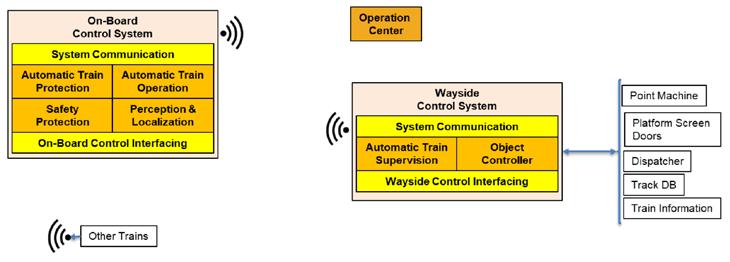
• Braking Intervention Curves: Continuously calculate braking distance requirements based on current train speed and known terrain parameters.
Automatic Train Operation (ATO) is the autonomous function that performs the following tasks to operate the train:
• Route Monitoring: monitor the route (tracks and environment) to ensure there are no impediments to train progress.
• Platform Monitoring: Monitors the safe approach and capabilities of a platform the train is going to stop at.
• Precise Stop Control: control the braking of the train to make precise stops.
• Train Speed Control: Control speed.
• Schedule Management: determine what actions are needed to maintain the train schedule.
• Door Control: Control opening and closing of the train doors on passenger trains.
• Intelligent Driving Subsystem: to be discussed later.
Safety Protection (SP) is the autonomous function that performs the following tasks to safely operate the train:
• Lateral Intrusion Protection.
• Collision Protection.
• System Integrity Protection.
• CIP Safety.
Perception and Localization (PL) is the autonomous function that performs the following tasks to assist in safely operating the train:
• Near-field Surrounding Perception: an AI/ML algorithm that processes images of the surroundings of the train to determine safe passage.
• Image-LIDAR Fusion Perception: AI sensor fusion algorithm that combines sensor data to determine safe passage.
• SLAM-IMU-GNSS Localization: Navigation algorithms to determine the location of the trains and the trains proximity to other trains and objects.
• Virtual Track Line Perception: AI/ML algorithm for comparing the track in the train path for any obstructions.
Intelligent Driving Subsystem and On-Board Control Interfacing
The Autonomous Train Control System in Figure 3 describes both the Intelligent Driving Subsystem and On-Board Control Interfacing features.
Intelligent Driving Subsystem (IDS) is
the autonomous function that uses AI/ML algorithms to perform the following tasks to drive the train:
• Automatic Path Tracking.
• Autonomous Guided Trajectory Following.
• The AI/ML algorithms will use Virtual Rail Forms that consist of: Painted Graphics, Magnetic Nails and Stripes, HD Maps, a Track Database (DBA) and Train information.
On-board Control Interfacing (OBCI) is the autonomous function that Interfaces to the train sensor and control equipment (i.e. Transponder Reader, Tachometer, Brake).
Wayside Control System
The Wayside Control System (WCS) identified in figure 4 consists of Autonomous functions that may use Artificial Intelligence /Machine Learning (AI/ML) algorithms to accomplish several tasks.
The On-Board Control System (OBCS) identified in figure 1 consists of Autonomous functions (illustrated in Figure 2) that may use Artificial Intelligence /Machine Learning (AI/ ML) algorithms to accomplish several tasks.
The Autonomous Train Control System in Figure 4 describes the Automatic/Autonomous

Figure 1: Autonomous Train Control System.
Figure 2: OBCS Autonomous Functions.

system that will support the Grades of Automation. Automatic Train Supervision (ATS) is the autonomous function that performs the following tasks to monitor and supervise the train:
• Train Monitoring.
• Operation Management.
• Track Resource Monitoring.
• Schedule/Route Monitoring.
Object Controller (OC) is the autonomous function that controls various machines supporting the train:
• Point Machine Control (Track Switches).
• Platform Screen Door Control.
Use Cases
Assisted (Train) Operation helps drivers avoid collisions with obstacles on the rail line. Assists the driver in monotonous or difficult traffic situations to minimize consequences and costs of accidents. Assisted Operation provides increased driver and passenger safety along with higher availability of trains and tracks. The benefits are:
• Avoid or reduce damage from accidents: Lower Repair costs and Higher train availability
• Improved punctuality and flexibility,
• Smooth acceleration and braking provide improved passage comfort,
• Improved safety.
Driverless Depot Operation institutes autonomous driving in the depot on semiprotected track areas at low speed. The benefits are:
• Operational even with reduction of personnel. Example: Reduced staff due to COVID,
• Reduction of accidents involving people in hazardous zones,
• Optimized vehicle transfer: Shorter wait times.
Driverless Vehicle Stabling and Provision is the automated transfer of trains to the stabling yard at end of operations as well as the automated provision of trains at start of operations. The benefits are:
• Reduce non-productive, time-consuming vehicle transfers,
• Faster provision of additional rail vehicles at time of peak demand,
• Trains can operate in parallel instead of waiting for worker to hop between trains.
Driverless operation on Specific Sections is the Autonomous System taking over the complete driving responsibility in suitable areas like fully segregated line sections. The benefits are:
• Fewer non-productive, time-consuming vehicle transfers,
• Drivers can be deployed elsewhere in passenger rail operations,
• Improved safety for all users.
Fully Automated Operation on Entire Lines is the driverless and unattended train operation on entire lines. The benefits are:
• No need for drivers or conductors,
• More space for passengers by elimination of driver’s cab,
• New operating models possible: shorter

SOURCE: ODVA
headways, demand-driven train operation and elimination of fixed timetables.
Additional autonomous benefits
Increased capacity: Automation expands passenger capacity by increasing the number of trains a line can handle. Many networks are already operating at full capacity and simply cannot handle additional trains, but automation creates space by eliminating the variables caused by human behavior.
Greater flexibility: Automating train fleets creates predictability, and that predictability enables greater flexibility. When supported with Automatic Train Operation, operators have more choices. They can automate service on seldom used or remote lines, automatically park a train, quickly respond to changes without needing a human driver to always be present.
Lower costs: Services like maintenance account for a large part of the costs of operating a fleet. Autonomous train technology ensures that trains are operated as efficiently as possible; reducing wear and tear while minimizing the incremental inefficiencies that are natural to human influence.
Enhanced passenger experience: Automatic train operation is not just for engineers and operators, it greatly improves the travel experience for passengers. Supported by technology, drivers can focus on passenger attendance and strategic decisions, meaning passengers will notice smoother acceleration and stopping, more comfortable curves and seamless transport options that have fewer delays.
More sustainable: Eco-driving rail automation systems reduce energy consumption and are key to making the rail industry more sustainable. Automatic train operation orchestrates rail fleets, empowering operators to run their trains more efficiently. Performing as a single connected system, this improved synchronization translates into maximum performance that helps reduce emissions and limit energy use.
George A. Ditzel, Industrial Communication Network Architect, Schneider Electric.
Figure 3: IDS and OBCI Diagrams.
Figure 4: Wayside Control System.
Optimize control panels and more with Single-Pair Ethernet
EtherNet/IP-based approach to connecting in-cabinet components reduces wiring, weight and installation time For producers looking for ways to do more with less, rethinking control panel connectivity with Single-Pair Ethernet (SPE) technology can be an impactful change.

ONE OF THE GOALS OF CREATING SMARTER and more sustainable production operations today is to help industrial producers do more with less. And one area of the automation infrastructure where OEMs, system integrators and producers are realizing they can do this is in the control panel.
Today, in-cabinet components like motor starters and panel operators are typically hardwired. And because these components can require hundreds of connections, control panels can take considerable time and effort to design, build, configure, commission and maintain. Wiring in control panels also occupies valuable space; today's manufacturers want to minimize that space to make the most of their production footprint.
An EtherNet/IP-based alternative connection approach offers a better way forward than the use of extensive hardwiring. Specifically, the use of single-pair Ethernet (SPE) allows in-cabinet components to be
connected more simply and easily via a flat media cable. This allows for cleaner, more efficient and more sustainable cabinet designs that can be installed faster and support the shift toward more data-driven decision making.
The opportunity
An in-cabinet connection system that uses SPE allows industrial producers to take EtherNet/IP deeper than it’s gone before – down to the simplest cabinet components – based on the IEEE 802.3.cg Ethernet standard and ODVA’s EtherNet/IP specification.
An SPE gateway translates a user’s full Ethernet stack to SPE when connecting to in-cabinet components. And multi-drop topology allows up to 39 in-cabinet components to be connected in a simple and clean panel design.
This approach replaces traditional pointto-point hardwiring with network-based
connections. And by eliminating this dense wiring and the need for extra wire trays, producers can either get more room in their cabinets for value-added features or reduce the size of their cabinets to save floor space.
A simplified wiring approach can also provide other benefits, including:
Reduced wiring time: With traditional point-to-point hardwiring, each wire must be cut, stripped, labeled, and terminated. This process can take up to six minutes per connection, creating significant time and labor demands for panels that have hundreds of connections.
With SPE, in-cabinet components can be quickly snapped into place on a simple piece of media, without the need for special tools. This can deliver big time savings. In fact, with one recently launched product, field testing sites reported up to an 80% reduction in wiring time and as much as a 50% decrease in testing time. It can also help reduce dependence on hard-to-find
An in-cabinet connection system that uses SPE allows industrial producers to take EtherNet/IP deeper than it’s gone before.
Virtual testing, real results: digital twin adoption expanding
With digital transformation, demand has emerged to speed up the process from product planning to commercialization. But the labor time required for rework, on-site adjustment due to problems during equipment development and delays in decision-making make it difficult to visualize the effects of investment.
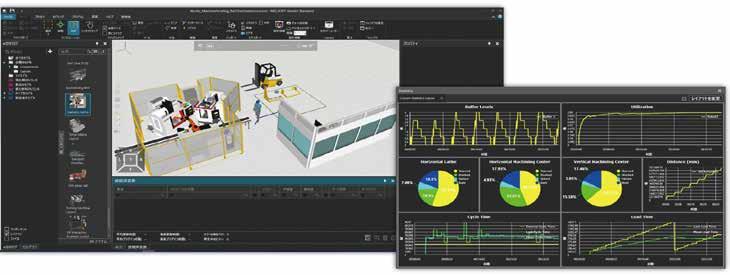
IMAGINE BEING ABLE TO TEST A COMPLETE production line 100 times, identify every potential bottleneck, and optimise all workflows without installing a single piece of physical equipment.
This isn't science fiction; it's a reality that's transforming manufacturing across Europe. Forward-thinking enterprises are already eliminating costly trial-and-error cycles and dramatically reducing time-to-market for new production systems. How? Through the power of digital twin technology - a virtual revolution that's quietly reshaping industrial processes.
The Manufacturing IT/OT Trend Report 2025 confirms this growing interest, indicating significant investment in digital twins across European manufacturing enterprises. Currently, 41 percent of organisations are in the pilot phase of implementation, while 20 percent report full integration and 15 percent use the technology in selected areas.
To understand what's driving this trend and how manufacturers can benefit from digital twins, Simone Faruggio at Mitsubishi Electric Europe, provides his viewpoint on the future of virtual manufacturing.
What's driving the shift to digital twins in manufacturing?
Simone Faruggio: Digital twins transform how we approach production planning. Traditionally, testing new setups meant physical trials and significant expense. With digital twins,
manufacturers experiment virtually before committing resources.
The digital transformation trend has created demand to speed up processes from planning to commercialisation. Digital simulation tools allow verification before actual implementation, helping identify issues early when changes are less costly.
How have you seen digital twin technology evolve in recent years?
SF: Digital twins have evolved from simple 3D representations to sophisticated environments that model complex manufacturing processes and integrate with automation systems.
The key advancement has been making these tools accessible to non-specialists. In our work with MELSOFT Gemini 3D, we've seen how this democratization empowers more team members to contribute to simulations.
What's critical is the integration with physical systems. A digital twin is only as good as its ability to accurately reflect the real world.
What specific challenges do European manufacturers face that digital twins can address?
SF: Let's start with the changing workforce landscape, both rising costs and growing shortages, that requires optimizing automation and human collaboration, which digital twins enable through detailed simulations.
This optimization becomes crucial when
dealing with supply chain disruptions. By creating virtual models of entire supply networks, we can help predict problems and develop more resilient systems, particularly important as customer expectations shift toward customization.
The demand for personalized products without increased costs pressures traditional methods. This technology allows efficient testing of customized processes virtually, while simultaneously addressing sustainability concerns through real-time simulation of energy usage and emissions. Ultimately, these capabilities give manufacturers the competitive edge they need through faster time-to-market. By front-loading development work in the virtual environment, this approach reduces commissioning time and helps manufacturers stay ahead in today's changing markets.
Could you walk us through the practical steps of implementing a digital twin?
SF: Implementation typically follows four stages: layout planning using 3D models; production flow planning to identify bottlenecks; virtual commissioning to verify programming logic; and ongoing monitoring after deployment This creates "front-loading" – shifting complex work to earlier project stages where changes are less costly. Control debugging can happen simultaneously with mechanical construction, reducing project timelines.
MELSOFT Gemini is 3D simulation software for virtually modeling machines and manufacturing processes.
What kind of return on investment can manufacturers expect?
SF: At our Nagoya Works facility, we used digital twin technology to optimise an assembly line with five work stations. By simulating improvement scenarios, we identified that adding one work station and implementing an intermediate work-in-process stand would improve efficiency. After implementation, the cycle time dropped from 128 to 92 minutes per unit – a 30% improvement.
Another example is an equipment manufacturer who used digital twins for front-loading development. They reduced construction time from 40 to 34 weeks, generating an additional 288,000 euros from earlier production with a payback period of just five days.
The ROI typically comes from reduced commissioning time, decreased downtime, and optimised resource utilisation.
How does AI integrate with digital twins in modern manufacturing?
SF: In "cognitive closed-loop manufacturing," AI agents in digital twins provide predictive support by analyzing equipment data, automatically triggering diagnostics when anomalies emerge.
AI-enhanced digital twins also optimize production workflows dynamically and simulate component-level failures, allowing manufacturers to spot wear patterns at a granular level. This shifts maintenance from reactive to strategic.
Could you explain how the virtual and physical worlds actually connect and work together?
SF: Robotic systems exemplify this connection. In our experience, MELFA robots create powerful synergy with simulation environments.
We first simulate robot placement and movements, determining optimal positioning and verifying range of motion before physical implementation. The teaching and collision checking can be completed virtually.
What's powerful is the automatic knowledge transfer. After teaching work in the simulation environment, the software generates robot programming with precise coordinates for the physical robot.
In one application, by performing carrier transfer in parallel with robot operation, we reduced cycle time by 30 seconds – from 1 minute and 20 seconds to 50 seconds. This optimization would have been difficult to discover without digital twins
Where are the most successful implementations of digital twins?
SF: It's difficult to point to specific industries that benefit more than others from digital twin technology. The potential applications and benefits are remarkably universal across all

LINE SIMULATION: Line simulation capabilities for people, robots, and Automated Guided Vehicles (AGVs). Innovative technology enables dynamic simulations of complex flow lines and operational scenarios with unparalleled accuracy and efficiency.
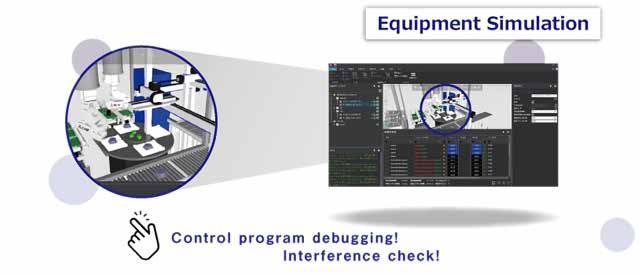
EQUIPMENT SIMULATION: Solution for equipment simulations of mechanical interference in 3D space, seamless integration with control devices for advanced logic validation, and real-time reproduction of error occurrences in immersive 3D environments based on log data.
manufacturing sectors.
In food and beverage operations, digital twins help ensure processes are efficient and compliant with safety regulations. In environments where robots, AGVs, and human workers interact, they help optimize workflows by identifying bottlenecks. Another application is real-time simulation of carbon emissions, giving manufacturers visibility into environmental impact.
The fundamental principles of digital twins—virtual testing, simulation, and optimization—translate across completely different manufacturing contexts, with core benefits of reduced downtime, faster commissioning, and optimized performance.
Is this technology accessible to smaller manufacturers?
SF: Historically, digital twins were primarily used by large enterprises with substantial IT budgets, but that's changing rapidly through modular software options and cloud-based solutions that reduce the need for expensive on-premises hardware.
Digital twins help smaller manufacturers where creating unique products or tailoring processes to specific client needs is a value differentiator, enabling them to run simulations
on complex products and opening opportunities for customization.
How will digital twin technology evolve over the next five years?
SF: Digital twins will become more autonomous and predictive, suggesting optimisations based on AI analysis. We'll see greater integration across entire supply chains, with nextgeneration digital twins simulating complete supply ecosystems.
Sustainability will become central to digital twin applications, optimising energy usage and minimising environmental impact. This is already expanding beyond manufacturing to other sectors. For example, digital twins are emerging as a powerful tool for Europe's energy infrastructure, enabling improved monitoring and decision-making across the lifecycle of grid assets.
Finally, user experience will improve through virtual and augmented reality interfaces that allow engineers to walk through virtual factories and interact with equipment using natural gestures.
Simone Farruggio, Product Marketing Specialist, Mitsubishi Electric Europe B.V..
Learn More
EtherCAT controls transport gigantic tunnel elements
Large Northern Europe’s construction site utilizes EtherCAT control technology distributed across a large number of control cabinets with a total connected load of 820 kW, a large number of analog EtherCAT Terminals and digital input/output terminals for recording signals and controlling the motors and hydraulic valves.
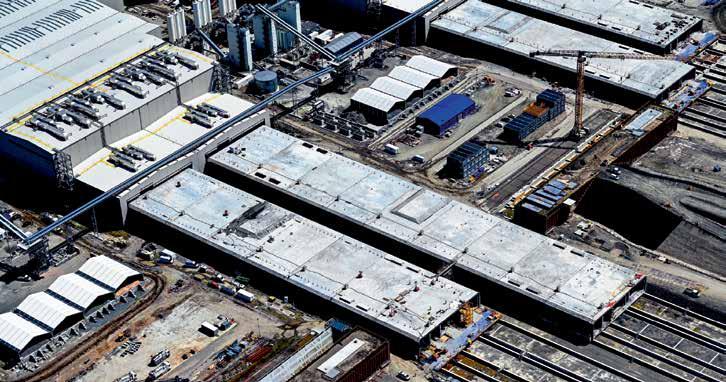
THE 18-KM LONG FEHMARNBELT TUNNEL between Rødbyhavn on Lolland in Denmark and Puttgarden on the German island of Fehmarn will be the world’s longest immersed tunnel by 2029.
To this end, 79 standard tunnel elements with a length of around 220 m and a further ten special elements are being manufactured on a 150-hectare construction site near Rødbyhavn. Swiss companies Hebetec Engineering AG and Elpex AG are automating and controlling the safe transport of the elements, which weigh over 73,000 tons, using EtherCAT terminals and PC-based control technology from Beckhoff.
The Fehmarnbelt tunnel is being built using the same technology that was used for the Öresund connection between Denmark and Sweden: immersed tunnels. The tunnel requires 79 standard and 10 special elements for installing the tunnel infrastructure. To start an element, reinforcing steel is connected to form a cage and pushed into prepared formwork. Concrete pouring then begins in the casting hall. Once the concrete has hardened sufficiently, the formwork is partially removed
and the first 24-m long segment is moved to make room for the next reinforcement cage. This process is repeated until all nine segments of a tunnel element have been concreted and successively pushed out of the hall into the dry dock. There, the 217-m long tunnel elements are sealed with bulkheads. Despite weighing around 73,500 tons, the components float when the dock is flooded
and can be pulled into the harbor basin. In order to meet the tight schedule for completion in 2029, the standard elements are being concreted on five parallel lines.
Moving gigantic masses precisely and quickly
Throughout the entire process, the huge tunnel segments are leveled on hydraulic

A total of 79 gigantic standard tunnel elements are being concreted on five lines in Rødbyhavn on Lolland in Denmark. Each element is around 220 m long and 43 m wide and weighs over 73,000 tons.
By 2029, the world's longest immersed tunnel will be built between Germany and Denmark with PC-based control from Beckhoff.
supports and pushed several hundred meters using hydraulic rams. The concept was developed by Swiss company Hebetec AG in Hindelbank and automated in collaboration with Beckhoff Solution Provider Elpex AG in Kirchberg.
“Moving the 43-m wide elements, which were over 200 m long in the end, safely and precisely from the concrete hall to the basin was a real challenge,” emphasizes Olivier Briguet, Head of Operations at Hebetec. Each line is fed by six double hydraulic cylinders with a stroke of 1.8 m, which are mounted on a movable frame that is pressed against the side of the skidding beams by means of jaws. The six rams press the segments evenly forward, then release their clamping, retract, and are pulled forward in the process. Then the process starts all over again.
“The skidding beams are around 400 m long and of course not perfectly straight,” Olivier Briguet points out a further complication. To avoid stresses in the concrete, the segments are continuously leveled using dozens of lifting cylinders. For the leveling of one segment alone, 36 presses – divided into three hydraulic groups – have to be controlled. This compensates for the tolerance of +/-5 mm and minimizes friction due to the smaller contact surface.
“The force required for pushing is significantly lower at 1.2% of the hydraulic power than the initially calculated 5%. This saves Femern Link Contractors, the manufacturer of the tunnel elements, a lot of energy costs,” says Urs Krähenbühl, deputy managing director at Elpex.
Furthermore, the weight of the segments is not homogeneous. This must be taken into account when pushing to prevent the tunnel elements from tilting – as must the different friction on the lifting cylinders. The tunnel segment will only stay on track if all pushers (presses) push with the same force.
“To do this, we use pressure sensors on each leveling ram to record the weight and use TwinCAT to control the pressing force of the pushers via the speed of the hydraulic pumps,” explains Benjamin Schwab, software team leader at Elpex.
In addition, the operator riding along on the segment in the control cabin can intervene and individually adjust the pressure of individual feed cylinders via an overflow valve. To assist the operator, there is a guidance system that detects and displays the direction. At the end of the construction hall, the 43-m wide segments have to pass through a relatively narrow gate in as straight an orientation as possible.
Control and monitoring station are riding along
The project involves the use of a large number of presses with a force of 240 to 390 tons and

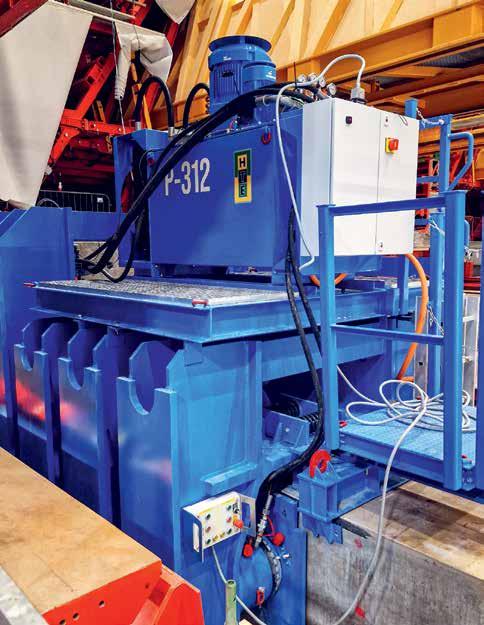
hydraulic accumulators to meet the operator’s requirements for continuous production of the segments at a rate of 10 m/h. Feed, leveling, and direction are monitored and controlled
Distributed across more than 100 control cabinets, over 1,000 EtherCAT Terminals record the forces and pressures on the presses, accumulators, and hydraulic units.
Six of these pushers, each with two cylinders, push the tunnel segments evenly over several hundred meters through a narrow gate into the dry dock during continuous production.
Ensuring uptime, resilient defense and network protection
A new mindset of intrinsic resilience breaks away from traditional perimeter-only protection frameworks by embedding security into every network node, and tightly integrating uptime with resilient defense to achieve seamless operational continuity.

IN THE RAPIDLY EVOLVING INDUSTRIAL Internet of Things (IIoT) and smart manufacturing landscape, network security is no longer just about preventing hacking or data breaches.
Operational stability and productivity now depend on it. For operational technology (OT) networks, resilient defense and consistent uptime are crucial. They are the core tenets that underpin Guarded Uptime and Resilient Defense (GUARD).
Redefining OT Security: Perimeter Defense to Intrinsic Resilience
Traditional network security primarily focuses on perimeter defense, such as firewalls, intrusion detection systems (IDSs), and anomaly monitoring. These defense mechanisms, essential for perimeter protection, may not fully address internal threats or device-level vulnerabilities on their own.
Let’s take a small to medium-sized water treatment plant responsible for providing clean water to a municipality as an example. Because downtime here affects public health, it must be avoided at all costs. The plant is subject to regulatory compliance requirements that mandate robust cybersecurity measures, requiring a network security solution that guarantees
continuous operation and meets stringent compliance standards. However, they have limited resources for incident response and recovery, and their main concern is to keep water cleaning operations running continuously.
In this scenario, the concept of GUARD is a perfect fit. GUARD distinguishes itself by going beyond network boundary protection. It embeds security within every network node while ensuring seamless integration with existing OT devices. This inherent resilience design enables applications like the water treatment plant to recover independently and maintain operations with minimal disruption, even during cyberattacks.
Three Core Strategies
Guarded uptime: For industrial networks, uptime equals productivity and revenue. Any network downtime can result in significant losses. Therefore, quick recovery of critical network devices from attacks or failures is paramount. Power redundancy, network redundancy protocols (STP, RSTP, MRP, Turbo Ring, Turbo Chain), and fast configuration restoration are crucial in minimizing production disruption.
Resilience from within: Built-in intrinsic defense, unlike traditional add-on security
architectures, embeds security directly into devices so that the network infrastructure achieves security by design. This includes:
• IEC 62443-4-1 certified secure development life-cycle (SDL), ensuring products adhere to the highest security standards from design to operation.
• IEC 62443-4-2 Security Level 2 hardened devices (covering everything from routers to Ethernet switches) with built-in multilayer network segmentation (Layer 2, Layer 3, VLAN) to block lateral movement of internal threats.
Collaboration and futureproofing: GUARD focuses on safeguarding existing networks while integrating new devices and technologies.
• Every proprietary network redundancy innovation (e.g., Turbo Ring or Turbo Chain) is compatible with standardized technologies (MRP, STP/RSTP).
• A network management system (NMS) supports third-party device monitoring and management, enhancing overall network visibility and operational efficiency.
• A vast partner ecosystem provides global and local support to meet the needs of different markets and industries.
Resilient defense and consistent uptime are the core tenets that underpin Guarded Uptime and Resilient Defense (GUARD).

Key Questions to Ask When Assessing Needs
Intrinsic vs. Add-on Security
• Is your goal to protect the entire network, not just its boundaries?
• Do you want to strengthen your network without the added complexity of external security overlays?
A “yes” to both questions means you should look for intrinsic security. As the name suggests, the security is built directly into the network devices such as routers, switches, and serial device servers.
This security-by-design approach, certified through IEC 62443-4-1, strengthens your network from the inside out, making it more resilient to attacks. Think of it as building a fortress rather than simply hiring guards.
Uptime and Resilience Focus
• What are the biggest challenges you face in maintaining the reliability and security of your industrial network?
• What is your current network redundancy strategy?
Although threat detection is vital,
prioritizing guarded uptime and quick recovery is key. Network redundancy protocols, rapid configuration recovery, and secure device design work together to minimize the impact of any security event on your operations. To avoid revenue loss from downtime, focus on keeping systems running smoothly. Use your network topology to help identify and resolve any issues efficiently.
Seamless Integration and Operational Efficiency
• Do you have a mix of legacy and modern equipment on your network?
• How do you handle patching and vulnerability management for your industrial devices?
Seamless integration of network security with your existing infrastructure and future technologies is essential. Broader compatibility with existing network redundancy protocols and network management supporting third-party device monitoring provides enhanced visibility and control across your entire industrial network. It’s crucial to find a solution that enhances
your operations without replacing your current investments.
Value Through Innovation: Combining Resilience and Stability
GUARD is more than just another security solution. It represents a new mindset of intrinsic resilience. It breaks away from traditional perimeter-only protection frameworks by embedding security into every network node and tightly integrating uptime with resilient defense to achieve seamless operational continuity.
To address the rising complexity and importance of IIoT and OT networks, Moxa seeks to strengthen industrial network security and operational stability, aiming to become a leading industry reference for network architecture.
Visit the Moxa microsite on learn more on enhancing industrial network security.
Laurent Liou, Product Marketing Manager, Moxa Europe.
Learn More
Seamless integration of network security with existing infrastructure and future technologies is essential. Broader compatibility with existing network redundancy protocols and network management supporting third-party device monitoring provides enhanced visibility and control across the entire industrial network.
Factory floor historian enables real-time data insights
Simple historians collect a few pieces of data for a short period. Some collect vast amounts of data that are transferred to an enterprise-level data lake. Some easily ship data to Excel for quick analysis. Others offer sophisticated analysis capabilities that provide direct insights into a process’s efficiency and productivity.

DOES YOUR FACTORY FLOOR HISTORIAN HAVE the seven indispensable power features that enable real-time data insight? The essential Historian checklist reveaks that you don’t need more data; the key is the right Historian.
It’s hard to believe but collecting factory floor data dates to Ford’s 1913 Model T production line in Highland Park, Michigan. No, they didn’t have automatic data collection. What they had were people who recorded information on every Model T coming off the production line. Steel filing cabinets filled with those production records were the historians of that era.
Today’s production runs are, of course, faster and more sophisticated with a variety of run sizes and all manner of options, testing
sequences and quality checks. And just like in 1913, that data needs to be analyzed and archived. Today, however, instead of filing cabinets, we have data historians to hold the data.
And unfortunately, it’s just as hard to use the data in many of today’s historians as it was to use the production records in those old filing cabinets.
Indispensable features of a Factory Historian
Historian applications serve a variety of purposes. Some simple historians (a.k.a. data loggers) collect a few pieces of data for a short period. Some collect vast amounts of data that are transferred to an enterprise-level data lake. Some are designed
to easily ship their data to Excel for quick analysis. Others offer sophisticated analysis capabilities that provide direct insights into a process’s efficiency and productivity.
Factory Floor historians have a range of capabilities, and many have particularly glaring weaknesses. Some are weak at data collection, supporting only a single PLC type. Others are weak at normalization, data modeling or analysis. Some can’t publish data to today’s digital systems. Many older historians are insecure, especially those designed before factory floor cybersecurity became a requirement. Other flaws include installation complexity, insufficient triggering mechanisms and cost.
When planning a Historian application, the key first step is to understand your
When planning a Historian application, the key first step is to understand your objectives, both today and tomorrow.
objectives, both today and tomorrow. What data do you want to collect and from what devices? How is that data currently formatted? Do you want the Historian to normalize, scale and add metadata to the raw data? Do you want it to be both a data collection and an analysis tool? Or do you prefer to separate the data collection and analysis functions?
No matter how simple or complex your application is, the following checklist can guide you through the selection process. The most indispensable features of a Factory Floor Historian are:
Connectivity: The ability to ingest raw machine data from your PLC, I/O system or network device is critical. More connectivity is not better. Support for hundreds of drivers you will never use provides no advantage. Support is much more important than the number of drivers. Knowing that the product is based on a reliable connectivity source that provides excellent support is more important than a large driver set.
Normalization / Scaling: Raw machine data is rarely in a format usable by enterprise applications. And more often than not, the same data point in two side-by-side systems will be formatted differently. Normalization and scaling is a requirement for your historians.
Modeling: Data modeling (collecting a group of related data together) is now, thanks to Smart Manufacturing and Industry 4.0, a necessary requirement. It would be nice to say that Historians should support both standard and userdefined custom data models. However, there is such a variety of standard models, defined in many different formats, that supporting them is difficult for the purveyors of Historian technology. If your company defines corporate models, it is best to inquire if your particular model can be loaded into your chosen Historian.

New historian allows tags from multiple PLCs to be captured, normalized and saved; user-defined models can be filled, published on demand without subscriptions, licensing constraints or reliance on third-party middleware.
slightly different than transferring, means making some select pieces of data (usually encapsulated in a model) available over an open protocol like MQTT, MQTT SparkPlug, OPC UA or REST.
ongoing maintenance costs.
Footprint: Historians can be deployed as a hardware module or downloadable software. The advantages of downloadable software include unlimited disk space and no additional hardware requirements. Just create a new VM for your Historian. The disadvantages include the deployment complexity and ongoing subscriptions. This is where the interests of plant personnel diverge from the interests of an Integrator.
Software historians are preferred by integrators as they make life easy for the Integrator. A software historian can be downloaded, integrated into a broader application, tested and delivered with little hassle. Unfortunately, that leaves the plant with ongoing deployment costs for as long as that Historian is in service.
Price: Subscription pricing models are much more costly over time. You pay forever to use it, whether you use it once or twice a year or continuously.
Goldilocks finds the "just right" Gistorian
There are a large variety of Factory Floor Historians, everything from simple data loggers to large database systems such as OSI-PI to PLC-rack modules capable of high-resolution PLC data tag capture. These systems are often overly complex, expensive or lack one or more of the indispensable features listed above. Just like Goldilocks, factory floor operators could only choose from underfeatured solutions (lacking one or more of the indispensable features listed above) that don’t fit or are complicated, over- engineered and expensive solutions.
Flexible Triggering: Triggering is about on-demand data collection from a process. Data collection should occur on a userdefined schedule, at the end of shift, when a process ends or when some kind of process upset happens. Your application data collection and diagnostic data collection are seldom scheduled, so the ability to trigger data collection on a wide variety of events and values is important.
Transferring & Publishing: Once data is collected, it is more useful if it can be transferred somewhere or published. Transferring data can be as simple as copying a set of data to a USB stick (if your corporate standards allow it) or copying a CSV file to some server where it can be consumed by another application. Publishing, which is
Cybersecurity: This is a new requirement that depends on your specific application and the cybersecurity policies of your plant. Cybersecurity requirements can vary from no security to compliance with a standard like IEC 62443 or with the CISA guidelines or the European Cyber Resilience Act (CRA).
Time Sync: All time-series data must be timestamped at the source using a common reference such as Network Time Protocol (NTP), Precision Time Protocol (PTP) or internal real time clock.
Other considerations
Beyond the indispensable features of a factory floor historian, there are three other important considerations:
Simplicity: As with most other products, the more features a Historian offers, the longer and more costly is deployment. Increased complexity always increases deployment and
Real Time Automation’s new PLC Historian fixes that. The RTA PLC Historian is easy to install and fast to configure, with just the right set of features for most time-series data collection applications. Tags from multiple PLCs are captured, normalized and saved, user-defined models are filled, published on demand without subscriptions, licensing constraints or reliance on third-party middleware.
With configurable storage up to 1 TB, a complete suite of publishing protocols (SQL, HTTP, FTP, WebSockets, USB, MQTT and email) and direct integration with InfluxDB for visualization and analytics, the Historian is an invaluable tool for plant floor operations, maintenance and process engineers.
John Rinaldi, Chief Strategist and Director of Creating WOW!, Real Time Automation (RTA).
Learn More
Robotic security use cases and implementation
In securing the future of robotics, cybersecurity is paramount. Robust measures, such as secure authentication, encrypted communication, and supply chain security, are crucial to protect against threats. Solutions provide advanced security features, ensuring the integrity and reliability of robotic systems.

In securing the future of robotics, cybersecurity is paramount. Robust measures, such as secure authentication, encrypted communication, and supply chain security, are crucial to protect against threats.
IN THE ARTICLE “ENSURING A SECURE FUTURE for Robotics: The Role of Cybersecurity”, (see the September/October 2025 issue of the Industrial Ethernet Book), we offered a comprehensive overview of the security challenges faced by robotic control systems.
We highlighted the criticality of adhering to industrial security standards in robotics and explored the essential security capabilities necessary to fortify the protection of robotic control systems. Additionally, we provided a preview of how Analog Devices’ security products could be utilized to implement a specific robotic security use case. In this article, we will provide an overview of the components that constitute an industrial robot/cobot. It’s worth noting that many of these similar components are also commonly
used in autonomous mobile robots (AMRs) and pick-and-place systems. Subsequently, we will explore various robotic security use cases, showcasing how security products simplify the implementation of security in these diverse robotic control systems.
Building secure robotic control systems
We are revisiting this section from the previous article for a better understanding of key technical capabilities and technologies required to implement secure robotic control systems, which include:
• Secure authentication: Integration of secure authenticators to verify device/ component identity.
• Secure coprocessors: Utilization of
dedicated hardware for secure storage and cryptographic operations.
• Secure communication: Implementation of encrypted protocols for protected data exchange.
• Access control: Enforcement of granular permissions to restrict unauthorized system access.
• Physical security measures: Incorporation of measures to protect against physical tampering.
In addition to these aspects, system developers must adopt a structured approach to secure development, including requirements gathering, threat modelling, secure design, implementation, testing, certification, and maintenance. Following a secure development life cycle (SDL) ensures security from the start.
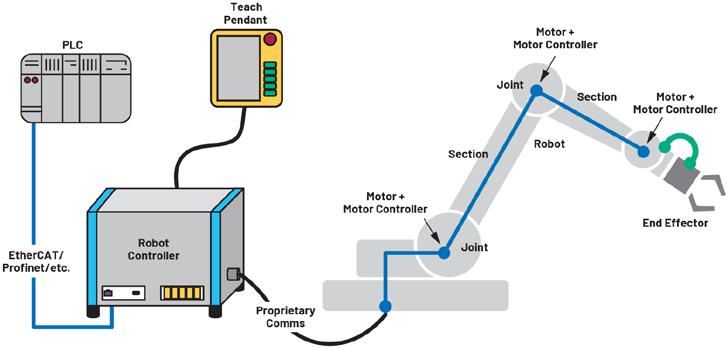
An overview of components in industrial robots and cobots
Figure 1 shows components associated with the operation of industrial robots/cobots. Table 1 gives an overview of different components.
Trusted PLC operation and gateway protection
The combination of PLCs and robotic controllers offers precise control in factory automation
Component Name
Sections
Joint
Robot controller
End effector
Programming interface (teach pendant)
Programmable logic controller (PLC)
setups, enabling fine-grained control over various processes.
In recent years, advancements in robotic technology have led to the development of integrated controllers that possess PLC-like functionality. Ensuring the reliability and security of PLC operation is of utmost importance when it comes to maintaining the safe operation of a factory automation setup.
Description
Usage of devices like the MAXQ1065 (the ultra low power cryptographic controller with ChipDNA® technology for embedded devices) within PLCs can support the following use cases:
NOTE: ChipDNA technology harnesses unique traits of electronic components to generate a secure cryptographic key. This key isn’t stored in memory or any fixed state, greatly enhancing protection against cyberattacks.
The central physical component, several sections are interconnected using joints and driven by motors. The arm enables precise movements.
Two sections are interconnected using a joint and the joint has a motor and motor controller, which controls the movement of the section connected to it. Sometimes only the motor is kept in the joint and the motor controller itself is outside of the joint in industrial robots.
Serves as the central intelligence of the robot, coordinating kinematic movements and actions. It enables communication from the controller to various joints and the end effector. The controller itself connects to the external world using industrial communications protocol like EtherCAT® PROFINET®.
Tooling attached to the robot arm can carry out actions like gripping, welding, cutting, etc. The end effector may have sensors that directly interact with the cloud and there are cases where the end effector directly connects to the robot controller.
Allows operators to teach and configure robot actions.
Can be used in conjunction with a robot controller to enhance a robotic system’s automation and control capabilities. A standalone robotic system might not connect to a PLC.
Figure 1. Components of industrial robots/cobots.
Table 1. Overview of Components of Industrial Robots/Cobots.
• Secure identification and clone prevention of the PLC modules.
• Secure boot and firmware download.
• Asymmetric key mutual authentication between PLC modules and PLC servers.
• Establish secure communication session with ECDH key exchange.
• Use of AES for encryption and decryption of network packets.
Direct Node to Cloud Security
Node-to-cloud communication (see Figure 3) in robotics enables several functionalities such as remote monitoring, data analysis, software updates, etc. It is crucial to secure the communication happening between the node and the cloud.
The MAXQ1065 offers enhanced security features for sensor-to-cloud and sensor-togateway communication:
• Enables the implementation of transport layer security (TLS) protocol, ensuring secure and encrypted data transmission. TLS verifies authenticity and safeguards sensitive information, making it essential for secure communication between nodes and the cloud.
• Facilitates secure communication for proprietary sensor-to-gateway or node-togateway connections. The controller helps establish a protected communication channel by enabling key exchange and data encryption, enhancing security for RF-based or other proprietary protocols.
• Offers additional security features like node authentication, trusted node operation, secure boot, and secure firmware updates. These features enhance system security by validating node identity, ensuring trusted operations, and protecting against unauthorized modifications.
Sensor Data Protection
• Data at rest can be encrypted with ChipDNA technology.
• Critical calibration data of sensor or sensor configuration information can be stored within the secure storage of the MAXQ1065 to prevent it from tampering or leaking. Further, it can be stored encrypted in the system. See Figure 4.
Supply Chain Security
Supply chain security includes broad topics. See Figure 5.
• Prevention of product clones (counterfeit).
• Securing software-based feature enablement to prevent IP loss and revenue loss.
• Verification of hardware authenticity. See Figure 6.
Supply chain security can be easily enabled by using ADI’s secure authenticators.
• Preprogrammed authenticators from ADI provide robust protection against counterfeiting.
• Secure life cycle management and key




management ensure assets remain secure throughout the device/product’s life cycle.
• ADI’s authenticators enable secure feature enablement, protecting valuable intellectual property.
Secure PLC to Node Communication
Secure authenticators can help secure communication, for example, between PLCs and actuators or sensors and between PLCs and the supervisory control and data acquisition
Figure 3. Integration for the MAXQ1065 to enable the direct node to cloud security.
Figure 4. Sensor data protection.
Figure 5. Testing for authenticity with a challenge-and-response sequence.
Figure 6. A hardware authentication example using the DS28E01-100.
(SCADA) control system (in the PLC, not in the SCADA system). It helps enable TLS protocol, which is a widely used transport layer security protocol in internet protocol-based communications.
Joint Authentication in Robots
Implementing joint authentication (see Figure 7) in robots significantly enhances overall security by ensuring that only legitimate and authorized entities can interact within the robotic system. It effectively prevents unauthorized access, strengthens communication security, and contributes to the system’s overall integrity and reliability.
Joint Secure Boot
Joint secure boot (see Figure 8) in robots provides a strong foundation for a secure and trusted operating environment. It protects against unauthorized software execution, malware, and tampering, enhancing system security and reliability. By establishing a chain of trust and verifying the integrity of software components, joint secure boot ensures the overall integrity and authenticity of the robotic system’s operation. Joint secure updates are also enabled in a similar way.
Selective Feature Enablement in Joint and Robot Controller
Post successful secure boot the application microcontroller unit/processor/ field programmable gate array can read the secure configurable memory of the authenticator/ coprocessor to selectively enable the feature in the joint/robot controller. See Figure 9.
Calibration Data Storage—Joint and Robot Controller
Calibration data storage is critical to maintaining accurate measurements in peripherals that undergo individual calibration at the factory. By securely storing this data within an authenticator, organizations can ensure its integrity and protect it from unauthorized access. The host system can then retrieve and utilize this stored data, enabling more precise and reliable measurements from the peripherals. Secure calibration data storage enhances the overall accuracy and performance of the system, providing valuable insights and maintaining high quality standards.
Joint Secure Communication
Joint secure communication enhances the overall security posture of a robotic system, ensuring trusted and protected data exchange. See Figure 10.
Conclusion
In securing the future of robotics, cybersecurity is paramount. Robust measures, such as secure authentication, encrypted communication, and supply chain security, are crucial to protect

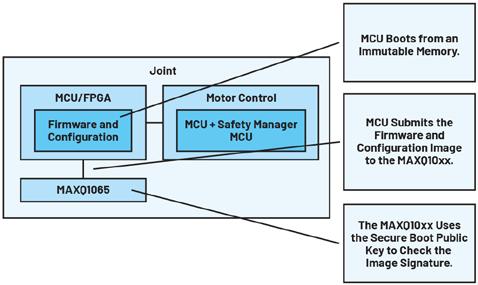


against threats. ADI’s products and solutions provide advanced security features, ensuring the integrity and reliability of robotic systems. By prioritizing cybersecurity and leveraging ADI’s expertise, we can unlock the full potential of robotics while safeguarding against emerging risks in an interconnected world.
Manoj Rajashekaraiah, Principal Engineer, Analog Devices.
Figure 7. Joint authentication.
Figure 8. Joint secure boot.
Figure 9. A typical joint block diagram.
Figure 10. Joint secure communication.
Calculating optical power budgets for industrial networks
Calculating an optic power budget may seem like a daunting task. In this article, the author demystifies the process by providing a step-by-step guide on how to determine a power budget to ensure signal integrity, prevent system failure and optimize network design.
CALCULATING AN OPTICAL POWER BUDGET is crucial for ensuring the overall operation and integrity of a fiber link from an Ethernet switch. An "optical power budget" refers to the quantity of light energy needed for a fiber-optic data transmission network or link to transmit signals from a transmitter power source (Tx) to a receiver (Rx) without signal distortion.
Calculating an optic power budget may seem like a daunting task, regardless of your level of experience as a technician or familiarity with industrial Ethernet switches.
In this article, we will attempt to demystify the process by providing a stepby-step guide on how to determine a power budget so you can ensure signal integrity, prevent system failure, and optimize your network designs.
Determining available power
To help calculate your power budget, fiber optic equipment manufacturers provide "Minimum Transmit Power" and "Minimum Receive Sensitivity" specifications. Minimum Transmit Power indicates the amount of power the Tx will transmit in a worst-case scenario, while Minimum Receive Sensitivity represents the minimum light needed by the Rx to operate error-free, also in a worst-case scenario. Be wary of specifications provided based on averages, since there is no guarantee that the device will perform at the stated average level as an absolute minimum.
Determining available power is the first step in establishing your optical power budget. The formula is as simple as subtracting Minimum Transmit Power from Minimum Receive Sensitivity.
For instance, if your source Tx device has a Minimum Transmit Power of -15dBm and the Rx has a Minimum Receive Sensitivity of -35dBm, your available power is -15dBm - (-)35dBm = 20dB.
Calculating link loss
From the moment output power is coupled into an optical fiber, the light energy is subject to losses brought on by inherent fiber properties and operating conditions. Measured in dB, this phenomenon is known in the network industry as Link Loss. Cable length, the number of connections, bends
and splices in the fiber optic cable, the type of fiber installed, and whether splitters were used are all factors to consider when estimating your loss budget.
By far, the largest contributor to loss is cable attenuation, which results in a loss of .22dB to .5dB per kilometer depending on the cable type.
You can find the attenuation marked on the cable you are installing or plan to install. In general, splices to the cable will generate an additional .1dB of loss per splice, while each connector will add .75dB according to TIA standards.
Once losses are added up, that number (loss budget) is subtracted from the available power you determined earlier. You’ll note that we calculated into the link loss formula two additional repair splices that may be needed in the future, and a Safety Margin of 3 dB to account for any unanticipated changes in temperatures, exceeding bend radii, aging of the cable and components, or end-face contamination, among other culprits.
1. Let’s start by assuming this cable run:
• Cable attenuation (1310nm fiber): .4 dB per kilometer
• Cable length: 2 kilometers between splices
• Splices: 4 @ .5 dB attenuation
• Connections: 2 @ .75 dB
• Repair splices: 2 @ .5 dB attenuation (recommended)
• Safety margin: 3 dB (recommended, varies on risk tolerance)
2. Next, let’s determine the Loss Budget:
• Cable Length: 10 kilometers x .4 db = 4 dB
• Connections: 2 connections x .75 db = 1.5 dB
• Splices: 4 splices x .5 dB = 2 dB
• Repair Splices: 2 splices x .5 dB = 1 dB
• Safety Margin: 3 dB
• Loss Budget: 4 dB + 1.5 dB + 2 dB + 1 dB + 3 dB = 11.5 dB
3. Finally, we calculate the working power budget for the cable run.
• Available Power: -15dBm - (-)35dBm = 20dB.
• Loss Budget: 11.5 dB
• Power Budget: 20 dB – 11.5 = 8.5 dB
Having arrived at a positive redundant power supply budget of 8.5 dB you can be confident that your installed prescribed optics will have sufficient power to provide reliable, error-free communications over this fiber optic run. However, if your number is negative, light signals will be too weak resulting in poor network performance.
The above is a simple example used only for illustration. In the real world, things are more complicated. One major factor is the use of devices from multiple manufacturers or different types of devices from select models of the same manufacturer. In this case, you will need to run the calculations in both directions, taking the Min Transmit power from the optics on one end with the Min Receive sensitivity on the other. The calculation with the lowest available power should be used in determining your power budget. Other issues you may need to consider are higher-order mode losses, and modal and chromatic dispersion in multimode fiber technology solutions.
If calculating the link loss in this way is not possible, once the fiber is installed, a tester can determine the loss of the cable run, which is ideal.
Final thoughts on calculating a power budget
An optic power budget indicates the total acceptable amount of optical power loss that a fiber optic link can have before signal performance is compromised. Losses result from factors including attenuation, the number of connectors and splices, as well as devices such as the source and receiver in the installed system.
Keep in mind that although it was not discussed here, it is possible to damage optical receivers by using too strong of a transmitter. This often is the issue when bench testing products before deploying them. Attenuators can be used to simulate longer cable runs to prevent damage.
If you need support determining optical power requirements, contact Antaira at sales@antaira.com, visit www.antaira.com, or call (714) 671-9000.
Henry Martel, Field Application Engineer, Antaira Technologies.
When Industrial Edge AI devices choke on data
Manufacturers increasingly need to rely on embedded edge experts to support and consult their data management plans, because managing data at the edge is no longer a simple engineering task, but a complex, high-stakes discipline.
IT’S A PAINFUL REALITY WHEN A PRODUCT that has taken years of engineering, validation, and promotion must be pulled from the market, not because of its core functionality, but because it couldn’t manage data correctly inside its embedded systems.
When devices fail to capture, store, and process data deterministically, small inconsistencies compound into unpredictable behavior, safety risks, and regulatory noncompliance. Logs become unreliable, AI models drift unchecked, and field updates turn into firefights. What began as an innovative, competitive solution becomes a liability, forcing costly recalls, damaged reputation, and lost customer trust. In industrial automation, medical, and automotive sectors where reliability defines success, poor embedded data management isn’t just a technical flaw, it’s a business-ending event.
In industrial automation, real-time performance is everything. Yet when an embedded device can’t properly manage and process data, it begins to choke along the control path. ISR or DMA bursts overrun small buffers, queues back up, and deadlines slip, causing jitter, oscillation, or overshoot in actuators and sensors. Blocking I/O and unexpected priority inversion allows low-level logging tasks to stall high-priority control loops. Meanwhile, unbounded data windows and poor memory hygiene strain limited RAM, triggering watchdog resets or unpredictable latency.
Flash storage introduces its own hazards: erase and wear-leveling cycles create latency cliffs that drop samples or corrupt event order, especially under power loss. Without solid data hygiene, clock drift, outliers, and mixed units creep in, confusing analytics and edge AI models, leading to false alarms or missed faults. If raw streams are dumped to the network unchecked, congestion, retries, and back-pressure ripple into control timing, eroding reliability. The results are costly: degraded product quality, unexpected safety interlocks, downtime, and frustrated operators.
Preventing this cascade begins with deterministic ingestion and queries, ensuring that control loops maintain hard latency budgets even during data bursts. Data durability and power-fail safety are equally
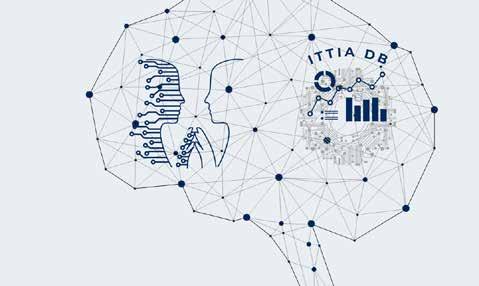
Platforms ensure industrial devices never choke on data, but think, decide and act intelligently.
vital, with crash-safe commits and flashaware writing that guard against corruption. Proper time-series modeling and indexing enable efficient capture, compression, and recall. Data validation, normalization, and labeling provide clean context for analytics and machine learning. At the edge, on-device feature extraction and inference turn raw sensor signals into actionable insight within milliseconds. Strong security, compliance, and selective synchronization keep operations resilient, cost-efficient, and scalable across fleets.
Manufacturers increasingly need to rely on embedded edge experts to support and consult their data management plans, because managing data at the edge is no longer a simple engineering task, but a complex, high-stakes discipline. From deterministic ingestion and power-fail-safe storage to on-device analytics, AI integration, and selective synchronization, every layer must perform flawlessly in real time under tight hardware constraints. A single design mistake, such as unreliable data capture, poor flash management, or inconsistent synchronization, will lead to costly recalls, production downtime, and even safety or compliance failures. Over the long term, poor data foundations also cripple product evolution, analytics, and customer trust. Partnering with embedded edge data professionals ensures that data is not just
collected, but properly structured, protected, and leveraged, turning a potential risk into a long-term competitive advantage.
This is exactly where the ITTIA and ITTIA DB Platform delivers value. With ITTIA DB Lite for MCU-class determinism, ITTIA DB for MPU-grade analytics, ITTIA Data Connect for secure and reliable data exchange between devices, and ITTIA Analitica for real-time observability and drift tracking, the platform ensures industrial devices never choke on data, but instead think, decide, and act intelligently.
Beyond software, ITTIA provides comprehensive support and consulting services that help manufacturers succeed throughout every stage of their product lifecycle, from concept to deployment and maintenance. Our experts assist with architecture design, data modeling, performance tuning, and AI integration to ensure each implementation is reliable, efficient, and future-ready. Through personalized consulting, hands-on training, and responsive technical support, ITTIA helps engineering teams accelerate development, reduce risk, and fully unlock the value of deterministic, secure, and intelligent data management at the embedded edge.
Sasan
Montaseri, Founder, ITTIA.
Learn More
Next generation inverters
Mitsubishi Electric unveils next-generation FR-D800 series inverters for enhanced efficiency and simplicity.

FR-D800 series inverters are designed to deliver performance, easy of use and improved energy efficiency in a wide range of industrial applications. SOURCE: MITSUBISHI
Mitsubishi Electric has launched its latest FR-D800 series inverters, designed to deliver better performance, easy operation, and improved energy efficiency for a wide range of industrial applications. Compact and intuitive, the new series delivers powerful performance alongside features designed to make selection, installation, and operation simpler.
With a focus on user-friendliness, the FR-D800 inverters feature a door-style surface cover and integrated wiring to make installation faster and easier. The FR-D800 is up to 37% smaller than its equivalent predecessor, reducing enclosure size requirements, allowing for more flexible mounting, and reduced installation costs. A new USB Type-C interface lets users set parameters directly from a PC without powering up the inverter, streamlining both setup and maintenance.
Parameters set without needing to power the inverters main circuit
The inverters can help save energy with advanced synchronous motor control,
which reduces power consumption and cuts operating costs. Its high-efficiency motor drive and lower standby power consumption also contribute to a reduced carbon footprint, supporting more sustainable production practices.
"With the FR-D800 series, we wanted to create an inverter that both new and experienced users can use with confidence," said Shotaro Marumoto, Inverter Development Section Leader at Mitsubishi Electric. "We've made it straightforward while delivering the advanced performance businesses need to improve productivity, save energy, and meet their sustainability goals."
The FR-D800 series is suitable for a wide range of applications, from conveyors and pumps to food processing equipment and textile machinery. Selected models are also suitable for harsh, corrosive environments, thanks to circuit board protection meeting IEC 60721-3-3:1994 3C2/3S2 standards.
Furthermore, FR-D800 inverters can control both induction and permanent magnet (PM)
motors, eliminating the need for multiple inverters for different motor types. Builtin support for popular Ethernet protocols including CC-Link IE TSN, Modbus/TCP, and EtherNet/IP ensures seamless integration into existing industrial networks, enabling users to quickly integrate it into their digital manufacturing and smart production environments.
The series also makes maintenance simpler. Its preventive maintenance functions include lifetime diagnostics for key components like capacitors and fans, helping operators spot potential issues early, especially when using the FR Configurator support software. Anomaly detection based on current patterns helps reduce the risk of unexpected downtime, and when a fault does occur, analysis functions solve the problem quickly.

SOURCE: MITSUBISHI
"Energy efficiency, simplicity, and reliability are essential for modern automation applications and industry in general," added Marumoto. "The FR-D800 series shows Mitsubishi Electric's commitment to providing solutions that meet these needs while contributing to a greener future."
The FR-D800 series is available globally with models designed for different voltage requirements, including single- phase 100V, 200V, and three-phase 400V options.
Mitsubishi Electric
Learn More
Comparison of power consumption (Mwh/year) and CO2 emission (t/year).
Zero Trust security for industrial networks
Secure Connect is a one-stop security platform for managing communication connections in OT networks.
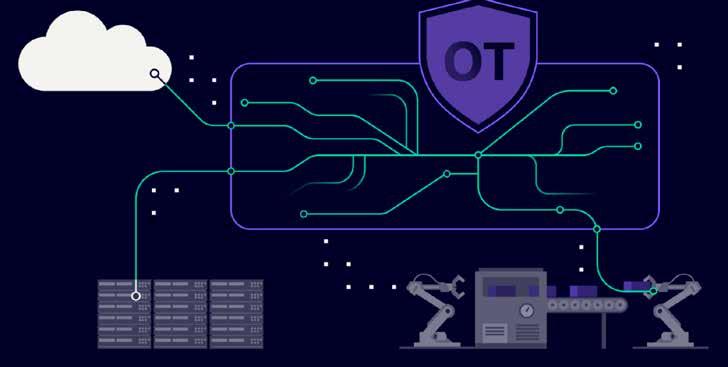
Secure Connect is the first zero trust security platform, according to Siemens, that is designed specifically for operational technology (OT) networks. The software solution virtualizes network structures using overlay networks. It enables Machineto- Machine, Machine-to-Cloud, and Machine-to-Datacenter connections, plus secure remote access to industrial systems –all without traditional VPNs.
Shop floor devices using SINEC Secure Connect remain protected from unauthorized external access while maintaining the necessary operational connectivity. This allows industrial companies to realize secure, flexible, and future-proof OT networking.
Addressing critical OT security challenges
The launch comes just as the global OT security market is projected to exceed $50 billion by 2030, according to industry reports, driven by the increasing digitalization of manufacturing and rising cyber threats targeting critical infrastructure and production environments. Industrial operators are facing mounting pressure not just from security threats but also from the administrative complexity of current solutions. “Traditional network security approaches struggle with the convergence of IT and OT systems, creating vulnerabilities when industrial systems connect to cloud services, remote access points, and external
partner networks,” says Michael Metzler, Vice President of Horizontal Management Cybersecurity for Digital Industries at Siemens. "With the SINEC Secure Connect platform, Siemens offers a cybersecurity solution that protects increasingly digitalized production networks while also helping to simplify network management."
SINEC Secure Connect addresses these interconnection challenges with an innovative zero trust architecture that creates a secure virtual overlay network above existing the OT infrastructure. The platform establishes end-to-end encrypted, identity-verified connections between authorized devices while protecting industrial systems from unauthorized external access.
Unlike traditional VPN approaches that create broad network access, SINEC Secure Connect implements granular, policy- based controls that prevent lateral movement, while reducing the administrative complexity of IP-based machine management and enabling cost-efficient compliance with IEC 62443 cybersecurity standards.
Deployments supported in any network environment
The platform's architecture enables flexible deployment options, including on- premises, cloud, and hybrid configurations. Its built-in redundancy makes it suitable for high-availability industrial environments, regardless of existing infrastructure
constraints. Unlike complex firewall-based approaches, its deployment flexibility is enhanced by simplified network administration that requires only outbound connections, eliminating the error-prone configuration management associated with traditional OT security solutions.
To maximize the return on existing investments, SINEC Secure Connect seamlessly integrates with the current SCALANCE portfolio for OT networks from Siemens, allowing companies to reuse their existing equipment while optimizing capital expenditures and reducing operational costs, thanks to a unified platform approach.
This integration strategy extends to legacy device protection, where the platform enhances Defense in Depth concepts with advanced cell protection capabilities for existing Siemens network devices – including SCALANCE S and SCALANCE MUM systems –to enable comprehensive security coverage across both new and established industrial installations.
SINEC Secure Connect is specifically designed for process and discrete manufacturing industries, solution partners, IT service providers, and operators of critical infrastructure who require the highest levels of security and operational reliability.
Siemens Visit Website
SINEC Secure Connect is the new Zero Trust security platform designed specifically for operational technology (OT) networks
Raptor switches and Cellulink routers
New EP4200 and EP5200 Layer 2 raptor switchers
The EP4200 and EP5200 series raptor switches feature advanced Layer 2 functions with high performance and availability. They have been specially designed for demanding applications in critical infrastructures and in the energy sector.
New products from Phoenix Contact are designed for demanding applications and explosive environments. SOURCE:
Designed to meet the stringent requirements of IEC 61850-3 and IEEE 1613 standards, these managed switches ensure reliable operation even under extreme environmental conditions ranging from -40°C to +75°C (up to +85°C).
The EP5200 model supports up to 28 Ethernet ports in a 19-inch format. The EP4200 supports up to 16 Ethernet ports in a compact DIN rail housing. Both models feature gigabit Ethernet communication via copper and fiberglass ports, with optional 10 gigabit ports available for high-throughput applications.
With a robust Layer 2 feature set, the raptor portfolio is engineered for environments where reliability, scalability, and compliance are non-negotiable. Whether deployed in substations, industrial supervisory control systems, or energy distribution networks, these switches have the necessary performance and resilience needed to operate in missioncritical processes.
Cellulink
outdoor cellular routers: cybersecurity for explosive areas
The Cellulink outdoor cellular router product range from Phoenix Contact is being extended. New versions are now also available that have been specially developed for use in Zone 2 potentially explosive areas. The devices have IECEx and ATEX approval and therefore enable safe operation in demanding industrial environments.
Particularly noteworthy is the end-to-end approval of the Cellulink cellular system with an integrated antenna. Unlike conventional cellular routers with an external antenna connection, the certification covers not only the individual component, but the entire system comprising the router, antenna path, and antenna, all housed in a vandal-proof outdoor housing. End users can therefore put the product into operation in potentially explosive atmospheres without further risk analyses, recertifications, or damping measures.
As with all devices in the Cellulink product family, the new versions also meet the requirements of the international IEC 62443-4-2 safety standard. The certified security forms the basis for a futureproof and investment-secure solution. In combination with the development process,

EP4200 and EP5200 Layer 2 raptor switches feature advanced Layer 2 functions.

Cellulink outdoor cellular routers are now available for use in Zone 2 explosive areas.
which has also been certified, and Phoenix Contact’s many years of experience, users benefit from a high level of cybersecurity for the reliable protection of their data and
processes against digital threats. Phoenix Contact Visit Website
PHOENIX CONTACT
RTConnect Historian for A-B PLCs
Hardware appliance designed to collect, store and visualize time-series data from PLCs—without SaaS fees.
Empowering control engineers to access and own the data from their Allen-Bradley PLCs, Real Time Automation has expanded the power of its RTConnect Historian for Allen-Bradley PLCs
Purpose-built for manufacturers and machine builders, the Allen-Bradley PLC Historian is a hardware appliance designed to collect, store and visualize time-series data directly from PLCs—without requiring complex software layers or ongoing SaaS fees.
Unlike traditional historian software that can be expensive and difficult to maintain, RTA’s Historian is a compact, plug-andplay device that sits inside the operational technology (OT) environment. It provides secure, local ownership of plant data while giving teams the historic data and reporting power they need to make better business decisions.
The newly released version builds on that foundation with expanded storage, more flexible publishing options, improved visualization and broader PLC compatibility, making it the most powerful and adaptable iteration to date.
Broader PLC support
The update adds full support for AllenBradley FlexLogix and Micro820, 850 and 870 PLCs, along with CompactLogix, ControlLogix, SLC, MicroLogix and PLC-5E systems. With automatic PLC and data-point discovery, the Historian simplifies integration and ensures continuous, accurate data capture across diverse installations.
Enhanced data access and publishing
The Historian now supports a wide range of publishing and access methods, including:
SQL (MySQL and Microsoft SQL Server), Email (SMTP), File Transfer Protocol (FTP), HTTP (JSON), WebSockets, MQTT (to brokers or cloud services like AWS) and USB drive export.
In addition, customers gain direct access to InfluxDB historical data, opening the door to Grafana visualizations and API integrations for advanced analytics.
Smarter data transformation and visualization
The update introduces data transformation tools, enabling addition, subtraction, multiplication, division, bitwise operations and even custom JavaScript rules before
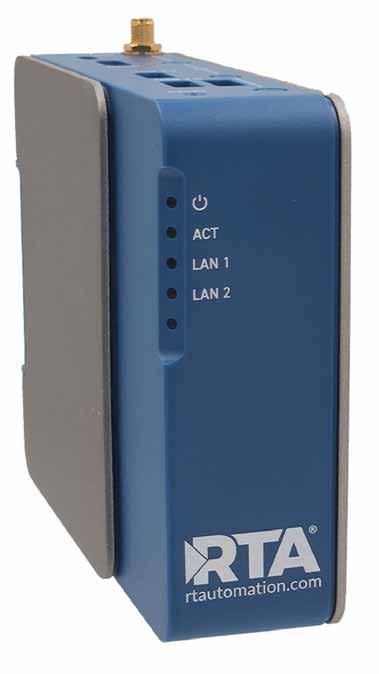
EP4200 and EP5200 Layer 2 raptor switches feature advanced Layer 2 functions.
storing or forwarding data. A redesigned home page dashboard improves data visualization, allowing operators to filter results by time and duration and download graphical views directly for further analysis.
Competitive differentiation
Unlike competitor products, the Historian combines high-capacity storage with flexible publishing triggers, customizable data transformations, MQTT support and secure multi-user account control— ensuring customers get a scalable, secure
and easy-to-use solution for managing industrial time-series data.
“We are bringing the market a 'No SAAS' historian product,” said Drew Baryenbruch, Real Time Automation. “We’re empowering users with improved access to data and information. Giving users the tools to make PLC data meaningful, actionable and accessible.”
Real Time Automation Visit Website
Uninterruptible IPC solution
Bicker introduces DIN rail bundle with AC/DC power supply, DC UPS and embedded Industrial PC for use in industrial automation applications.
Bicker Elektronik is offering presents a robust and fail-safe DIN rail bundle designed for control and automation tasks in industrial environments. The flexible DIN rail solution combines three perfectly matched components: the Delta DRL-24V120W1EN AC/ DC power supply, the Bicker UPSI-2406DP1 DC UPS with integrated Li-ion battery pack, and the GIGAIPC QBiX-DR-EHLA6412H-A1 DIN rail industrial PC. Together, these components ensure a reliable and uninterrupted 24V DC power supply as well as high computing performance for continuous operation in harsh industrial conditions.
Compact 24V power supply
A space-saving DRL-24V120W1EN DIN rail power supply from Delta Electronics delivers 120 W nominal output (24V / 5A) with an efficiency of up to 91%.
Compact DIN rail Industrial PC
The GIGAIPC QBiX-DR-EHLA6412H-A1 is a powerful DIN rail industrial PC for 24/7 continuous operation in demanding industrial environments.

Intelligent DC UPS with battery pack
The Bicker UPSI-2406DP1 protects critical systems against power failures, voltage dips and transients. Delivering 24V / 4A (96W), the UPS automatically switches to battery operation in the event of a mains failure.
DB and QNX Integration
ITTIA DB and QNX Integration powering real-time data management for embedded systems. SOURCE:
TTIA DB is now compatible with QNX® OS 8.0 – the latest version of the trusted real-time operating system (RTOS) from QNX. This marks an important step forward in enabling high-performance, mission-critical embedded systems with total data management capabilities.
By combining ITTIA DB with QNX OS 8.0, embedded systems gain robust, end-to-end data lifecycle management – from acquisition and storage to real-time processing, secure handling, and efficient distribution.
This powerful integration enables intelligent data operations directly on resource-constrained devices, ensuring unmatched reliability, deterministic performance, and safety-critical assurance in embedded environments.
This collaboration delivers advantages to manufacturers across sectors—including automotive, industrial automation, medical, and aerospace.
By leveraging real-time time-series data collection, edge analytics, and machine learning inference within a secure, POSIX-compliant environment, organizations can unlock intelligent decision-making at the edge. The

result is faster innovation, enhanced operational efficiency, and greater system autonomy— all within a robust and reliable embedded framework.
“Working with QNX OS 8.0 reinforces our mission to deliver scalable, reliable data solutions that empower embedded developers to design intelligent, autonomous systems,”
said Sasan Montaseri, President of ITTIA. “This collaboration allows our customers to build next-generation devices with trusted real-time performance and advanced data capabilities.”
Ittia
Learn More
Bicker Electronik
Ethernet switch focuses on reliability
Antaira’s next-generation M12 PoE IP67 water-resistant Ethernet switch provides ultra-reliable connectivity in rolling stock and automation applications.
Antaira Technologies has announced a new LNP-0500G-M12-67-T Gigabit PoE+ M12 unmanaged five-port industrial switch. By combining reliability, Power over Ethernet (802.3af/at), and certification to EN 50155 international standards, the new switch is optimized for uninterrupted connectivity in rolling stock or moving vehicles, as well as to accelerate digital transformations and bring industrial automation networks to peak performance.
“Day in and day out, Antaira industrial networking products perform under the rugged conditions, ensuring reliable operation while supporting your evolving digitalization demands,” said Joe Cook, General Manager, Antaira Technologies, LLC. “Our newest switch merges the innovation and dependability of Antaira industrial switches with a robust feature set specific to on-machine and rolling stock environments.”
Focused on reliability
Critical industrial applications rely on the high reliability of network switches to deliver real-time data with maximizes network uptime.
The ultra-reliable LNP-0500G-M1267-T safeguards critical connectivity from vibration, dirt, humidity and dust by incorporating M12 X-coded connectors in four Gigabit PoE+ 30W ports, along with a single M12 A-coded port to supply DC low-voltage power to field devices. M12 connectors, resilient against heavy vibrations and shocks in rolling stock, robotic and automation, provide tighter, more secure connections than RJ45 designs found on standard switches.
In conjunction with the M12 connectors are an IP67-rated waterproof metal housing and a wide operating temperature range of -40° to 167° F that allows for decentralized installation outside of a control cabinet, while its fanless design minimizes risk of mechanical failures.
PoE+ simplification
The LNP-0500G-M12-67-T brings a total PoE budget of up to 120W to PoE compatible devices like IP cameras, Wi-Fi access points, sensors, and digital signage, simplifying network infrastructures by consolidating power and data transmission through a single Ethernet cable.
Each of the switch’s four Gigabit ports supply up to 30W of power, making

By combining reliability, Power over Ethernet (802.3af/at), and certification to EN 50155 international standards, the new Antaira switch is optimized for uninterrupted connectivity in rolling stock or moving vehicles, as well as to accelerate digital transformations and bring industrial automation networks to peak performance.
Antaira’s solution highly adaptable to the tight, limited spaces on trains and buses, or on-machine integrations. By reducing the need for separate power cabling, PoE also lowers the costs associated with switch installation and maintenance. Since power is delivered through the network cable, devices can be placed in optimal locations without being constrained by the availability of power outlets.
Compliance to industry standards
The LNP-0500G-M12-67-T meets the marketspecific standards for multiple industrial
approvals and certifications, including EN 50155 and EN 50121 for rolling stock. In addition, it is compliant with UL, CE, FCC, and IEC standards to ensure safe operation even under the harshest electromagnetic, climatic and mechanical conditions. EN 50155 specifies requirements for electronic equipment on rolling stock, covering operating temperature, power input voltage, surge, ESD, and vibration.
Antaira
Learn More
Windows 11 25H2 in Real Time
With the release of KRTS 11 25Q3, the specialist for industrial real-time programming ensures complete compatibility with the recently released Windows version.
Kithara Software has announced immediate support for Windows 11 25H2 with its real-time operating system, Kithara RealTime Suite (KRTS). With the release of KRTS 11 25Q3, the specialist for industrial real-time programming ensures complete compatibility with the recently released Windows version.
Kithara RealTime Suite 11 25Q3 already enables users to utilize real-time functionality on the current edition of the Windows operating system. This includes hardware-dependent programming, precise multi-tasking operations, and the control of automation, machine vision as well as communication systems.
Once again, thanks to extensive testing processes with the Insider Program, the latest Windows version could be supported by the Kithara real-time operating system shortly after its release. This way, users are able to seamlessly continue their real-time applications and projects on the newest platform. Kithara RealTime Suite 11 25Q3, including 25H2 support, is available for download to all users of the full version as

well as the free demo version.
Kithara Software is a specialist for real-time solutions, especially for the Windows operating systems family. The real-time extension Kithara RealTime Suite is a comprehensive system library for hardware-
PTP and MACsec support
Optical Ethernet PHY transceivers deliver Precision Time Protocol and MACsec encryption.
To address the need for reliable and secure connectivity solutions, Microchip Technology has announced its new portfolio of Optical Ethernet PHY transceivers, available in 25 Gbps and 10 Gbps versions, featuring IEEE® 1588 Precision Time Protocol (PTP) and Media Access Control Security (MACsec) encryption.
Microchip’s optical Ethernet PHY transceivers provide a secure, deterministic and scalable alternative to traditional copperbased Ethernet solutions. They support link lengths of up to 10 kilometers over singlemode fiber for seamless deployments over dispersed infrastructure such as company and college campuses or warehouses. The integration of PTP time stamping delivers sub-nanosecond (<1ns) synchronization accuracy across distributed nodes. This level of timing precision is essential for time-sensitive applications such as industrial automation, telecommunications and robotics.
"Design engineers are looking for solutions that simplify complex networking systems, adding PTP or MACsec could mean a complete overhaul of an existing design, our solution helps preserve our customers’ core-processing
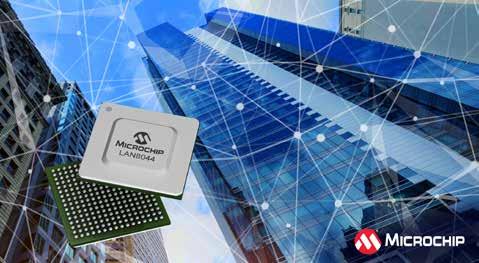
investment,” said Charlie Forni, corporate vice president of Microchip’s networking and connectivity solutions business. "We’ve integrated these capabilities into our transceivers, enabling bolt-on functionality to help engineers build smarter, more secure and scalable networks."
The new variants support Ethernet speeds
ranging from 1 Gbps to 25 Gbps, enabling higher bandwidth for data-intensive applications such as data centers, campus area networks, and robotic / industrial automation.
Microchip
Learn More
dependent programming, communication, automation and machine vision.
Kithara
Learn More
SOURCE:KITHARA
SOURCE: MICROCHIP
Industrial Ethernet Book
The only publication worldwide dedicated to Industrial Ethernet Networking and the IIoT.
Visit iebmedia.com for latest updates.

New website offers deepest, richest archive of Industrial Ethernet and IIoT content on the web.




View and/or download latest issue of Industrial Ethernet Book and past issues.
Search our database for in-depth technical articles on industrial networking.
Learn what's trending from 5G and TSN, to Single Pair Ethernet and more.
Keep up-to-date with new product introductions and industry news.
